Solo Shows
Ètudes De Paysage
Ping Pong 2023
Copenhagen, Denmark
Domaine d’Ètude
Spread Museum 2023
Entrevaux, France
Bigag & The Bando
AAAA Nordhavn 2022
Copenhagen, Denmark
Drafts of Ecology: Dear Landscape, RainRain Gallery 2022
New York, USA
Drafts of Ecology/Thought & Memory: Interior & Exterior
Kerka Gallery 2022
St. Petersburg, Russia
Drafts of Ecology: SIRENIA
Servando Gallery 2021
Havana, Cuba
Drafts of Ecology/Psyche Interior, Udstillingsstedet Q 2021
Copenhagen, Denmark
BFA Degree Show —
The Royal Danish Academy of
Fine arts 2021
Copenhagen, Denmark
Dream Structures
Ta-Da Space 2021
Copenhagen, Denmark
Drafts of Ecology/Beastial Fantasy, Patara Gallery 2020
Tbilisi, Georgia
CRITS
Brigade Gallery 2020
Copenhagen, Denmark
Roaming Away On
The Pillars Of Consensus
CGK 2018
Copenhagen, Denmark
Selected group shows
Land & History
Magma Maria 2024
Offenbach am Main, Germany.
Impressionisms
AAAA Nordhavn 2024
Copenhagen, Denmark
Spiritual World,
RAINRAIN Gallery 2024
New York, USA.
Mælkeveje
Nivaagaard Malerisamling 2024
Nivaa, Denmark
The Cave and the Cloud
Deutsche Film Institut 2024
Düsseldorf, Germany
AFGANG
Kunsthal Charlottenborg 2024
Curated by Post Brothers
Copenhagen, Denmark
A Little Bit of Solidarity
Goes a Long Way
Zirka.Space 2024
Curated by Kay Yoon
Munich, Germany
Radical Technology,
Norrecco ressourcestation 2023
Curated by Platform.dk
Copenhagen, Denmark
Anthology of the Field
Basecamp, Locarno Film Festival 2023
Curated by Justine Stella Knuchel
Locarno, Switzerland
Sweet To Tongue — Sound To Eye, Augustiana 2022
Curated by Sophia Luna Portra
Sønderborg, Denmark
Christmas Salon,
Alice Folker 2021
Copenhagen, Denmark
Make Friend Not Art: Underbellies Bundesallee 213-214 2021
Curated by Caroline Marie Ballegaard
Berlin, Germany
“HUMAN ERR0R”,
GMO Gallery 2020
New York, USA
Staff Only
Salon 75 2020
Copenhagen, Denmark
The Legend of the Larynx Metamorphosis
Garage 9 2019
Bologna, Italy
Zoom With Your Feet (Make Friends) Overgaden 2019
Copenhagen, Denmark
Homesick Gallery —
Fantastic Sunny Apartment And 10 Min To Manhatten 2019
Brooklyn, New York
Learning From
(Learning)Albertslund 2019
Albertslund, Denmark
Vibevej Præsenterer: Rentemestervej 69B 2019
Copenhagen, Denmark
Kunstnernes Efterårsudstilling
Den Frie Udstillingsbygning 2018
Copenhagen, Denmark
Calculation LIVE online-performance, Tashkent International Biennale for Contemporary Art 2018
Tashkent, Uzbekistan
Walther & Langgaards
Artists Supplies, Delfi 2018
Malmö, Sweden
Spring Exhibition
Kunsthal Charlottenborg 2017
Copenhagen, Denmark
Krystalpaladset
Odensemusikbibliotek 2017
Odense, Denmark
Das Irrlicht (Dank) 2022-2024
@ Kunsthal Charlottenborg
Copenhagen, Denmark
Curated by Post Brothers
Das Irrlicht (Dank) is a scenographic installation set in an artificial wetland that employs theatrical effects to mimic the perception of the Ignis fatuus, the natural phenomenon also known as the will-o’-the- wisp. An atmospheric and ghostly light seen by travellers at night, especially over bogs, swamps or marshes, the will-o’-the-wisp has long inspired superstition and folklore around the world, serving as a metaphor for hidden treasure, lost souls, a sinister delusion, or a goal that leads one astray. Modern scientists now agree that the flame-li- ke phosphorescence is caused by gases from decaying plants, which some would assume abolishes the spiritual qualities of the legend. Nymark’s project underlines the phenomenon not only as an expres- sion of how humans understand and translate experiences of their surrounding world and environment but also emphasizes how the spiritual interpretations of the light correlate with its material cause as a transformation of matter and energy.
The installation treats the bog as a stage, employing an amalgam of different elements such as controlled light systems, scent diffusers,
a smoke machine, sound and music, carpet, curtains and artificial plants, to produce an immersive environment for reflection and contemplation on this multifaceted, fecund, and spiritual biotope.
A late-romantic piano sonata overlaid with wetland field recordings adds to the mysterious dream-like quality of this simulated northern wetland. Additionally, displayed on a wall, an inverted photograph depicts a miniature model of Thomas Edison’s 1882 Pearl Street Station, the first commercial central power plant in the United States, which played a key role in the adoption of electric power and is an icon for scientific innovation and mass industrialization. Thus, the artist charts a tension between the development of the modern land- scape and the endurance of spirituality, magic, myth, and folklore at the end of the 19th century, using the wetland as a fecund and biodi- verse resource of energetic infrastructure where the past and present converge.
The project explores how industrialisation and spirituality throug- hout time seem to intertwine and cross paths in unexpected ways, and suggests that uniting these systems of belief can support a more integrated ecological consciousness and perceptual engagement amidst the dire consequences of environmental degradation and climate change. Bringing to light the beneficial and crucial qualities of the wetland, as well as its symbolic and affective properties, the installation offers a poignant reminder of humanity’s symbiotic rela- tionship with the environment and invites us to reconsider the role of myth in our seemingly disenchanted world.
— Matthew Post
Das Irrlicht (Dank) 2022-24
Flame LED light, Arduino, relay, extension cords, polyester carpet, full spectrum light tubes, MDF, mirror PVC vinyl film, artificial paper cat tails and grass, pine beams, Genelec speaker, media player, recording of Edward MacDowell’s 1900 composition Piano Sonata No. 3 in D minor (‘Norse’), Op.57, Kvadrat® linen and viscose curtains, curtain steel wire, smoke machine, smoke liquid, Gamma Wolpa Eurobox, wall mounted blowing fan with attached custom Scent bag.
Variable Dimensions
Pearl Street Station Model. 2024
Photogravure on Fabiano 100 gram cotton paper, laser engraved acrylic, painted passe partout in chrome plated aluminum frame.
32x40 cm
Archive (Hearth) 2024
Cardboard box, neolithic flint tool residue, mirror PVC film, Flame LED light, extension cords, dried twigs and leaves.
Variable dimensions
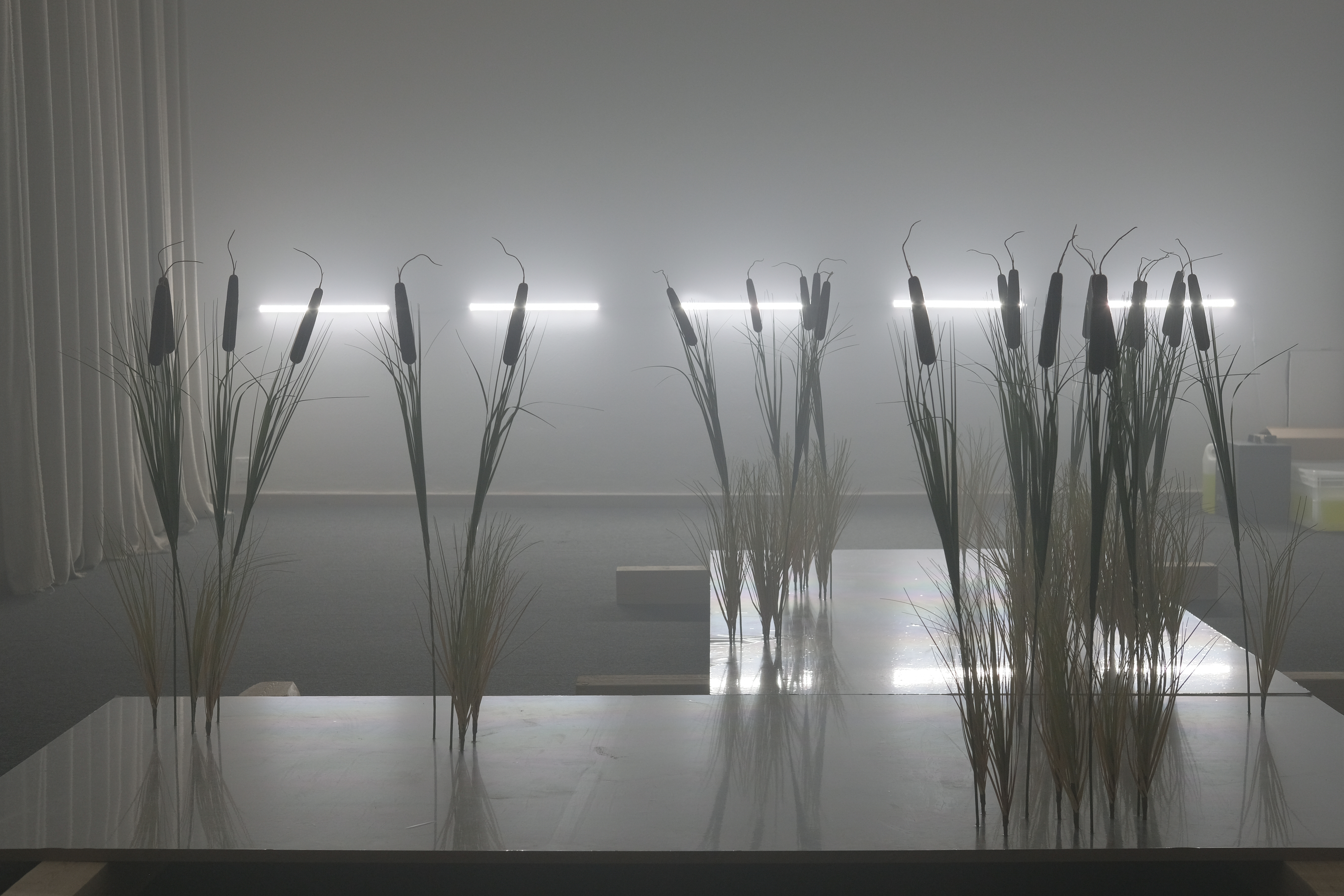
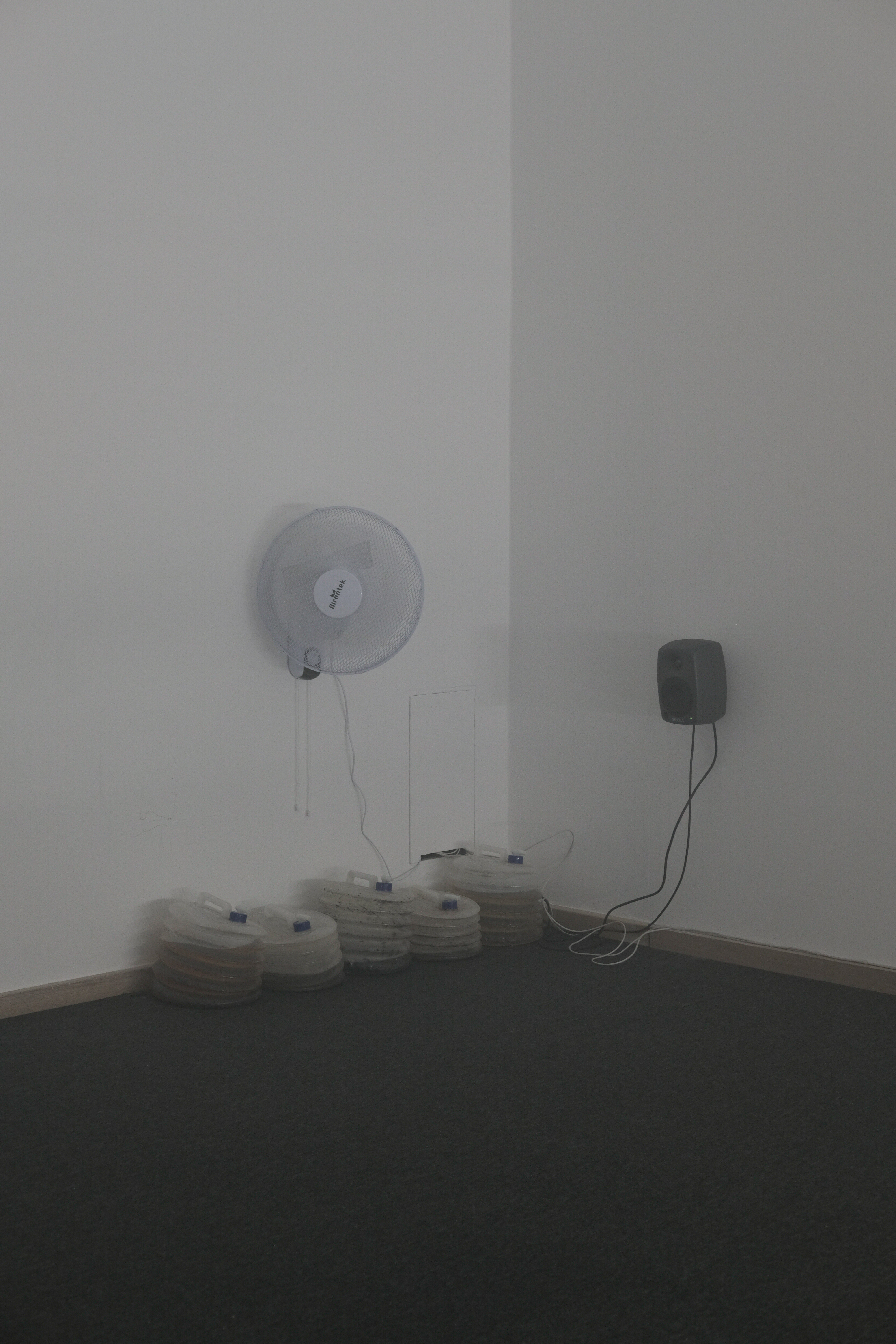
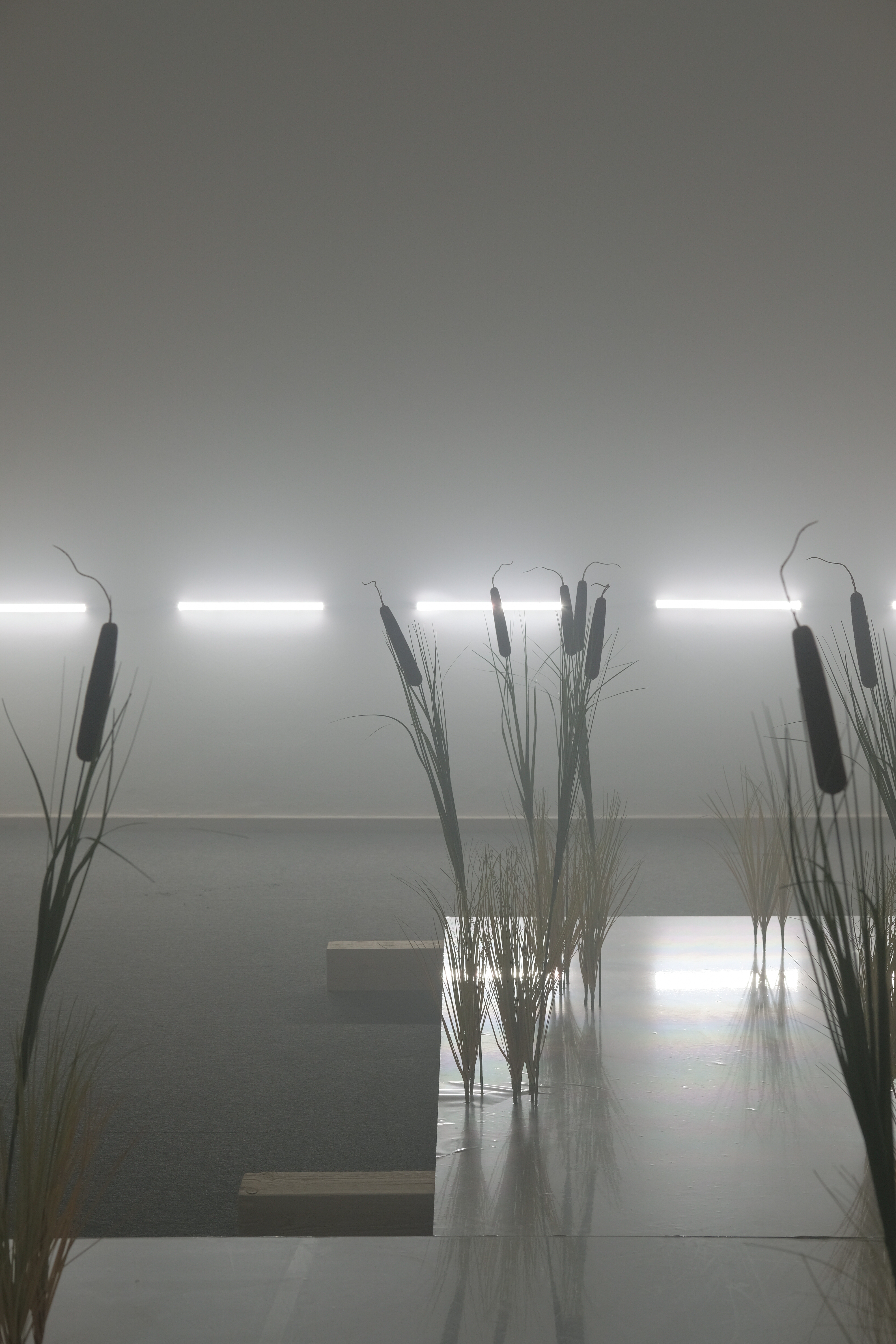

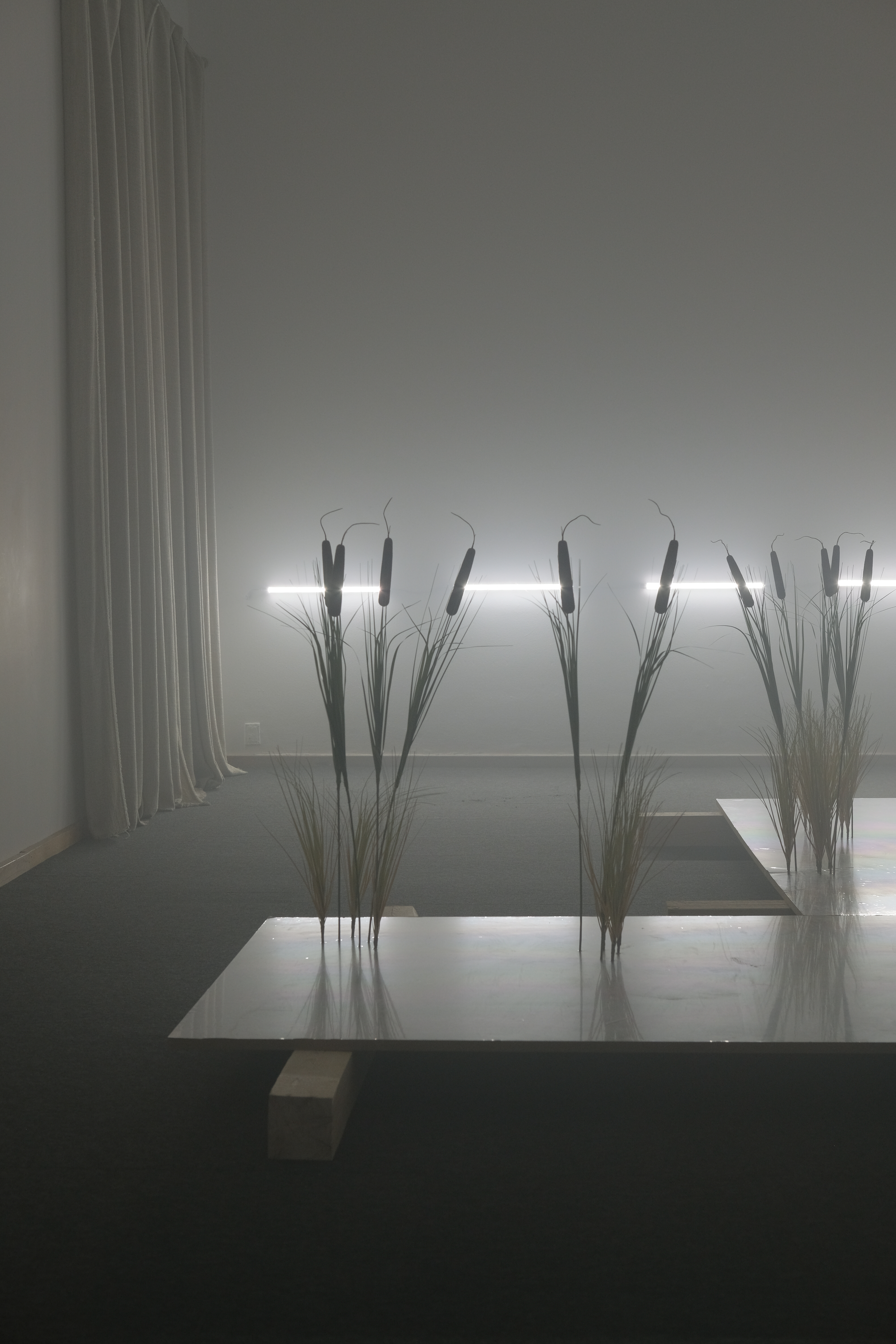
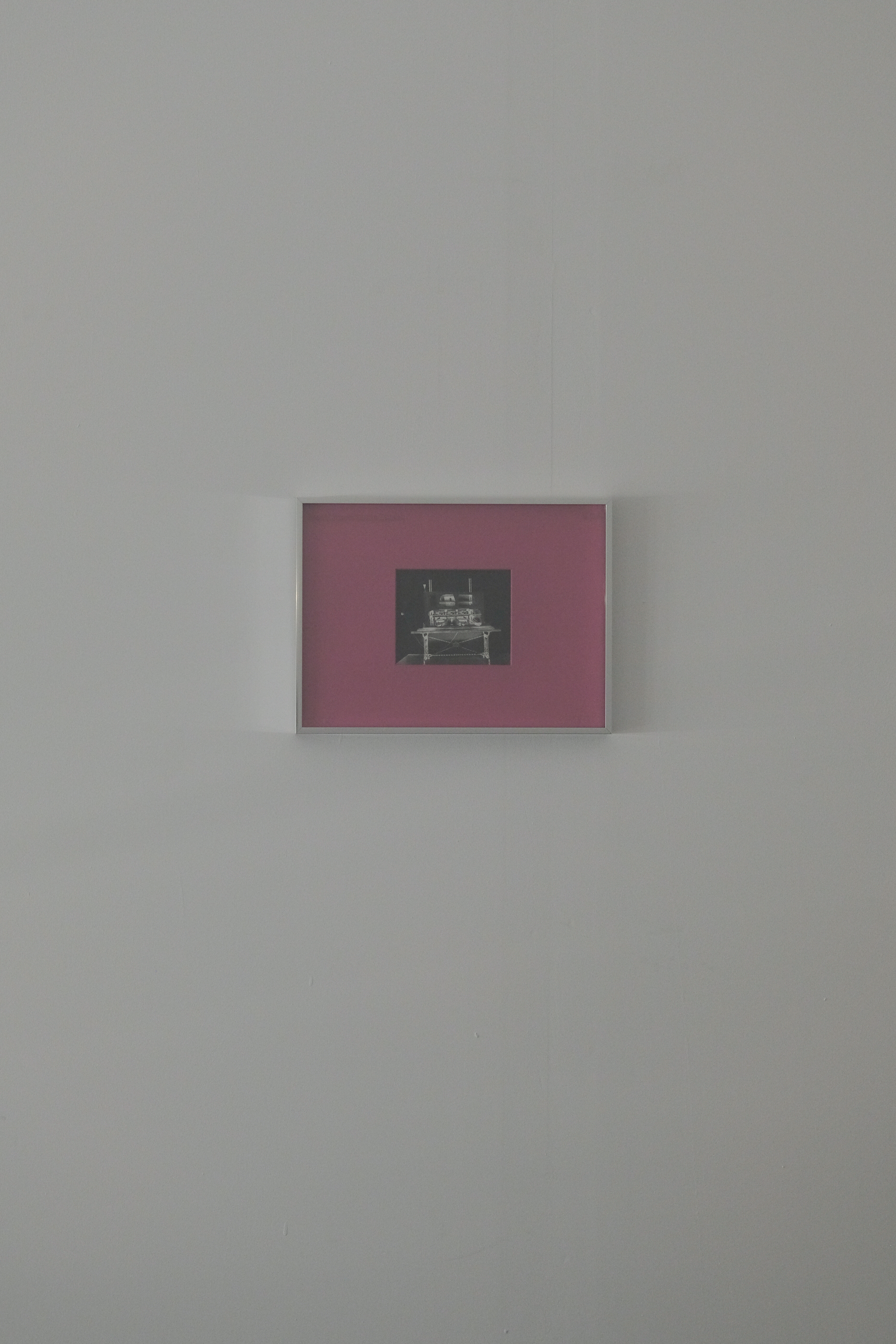

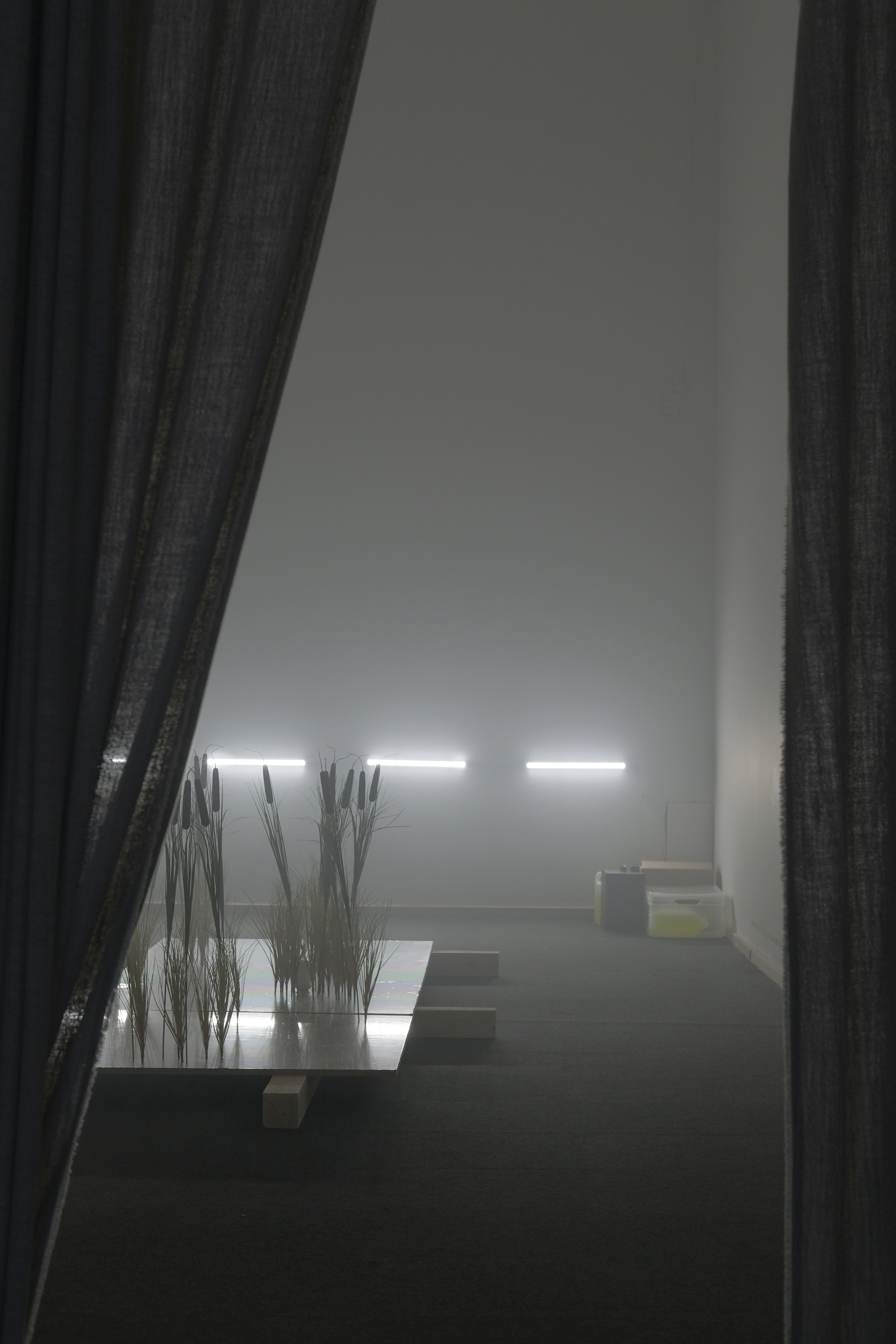
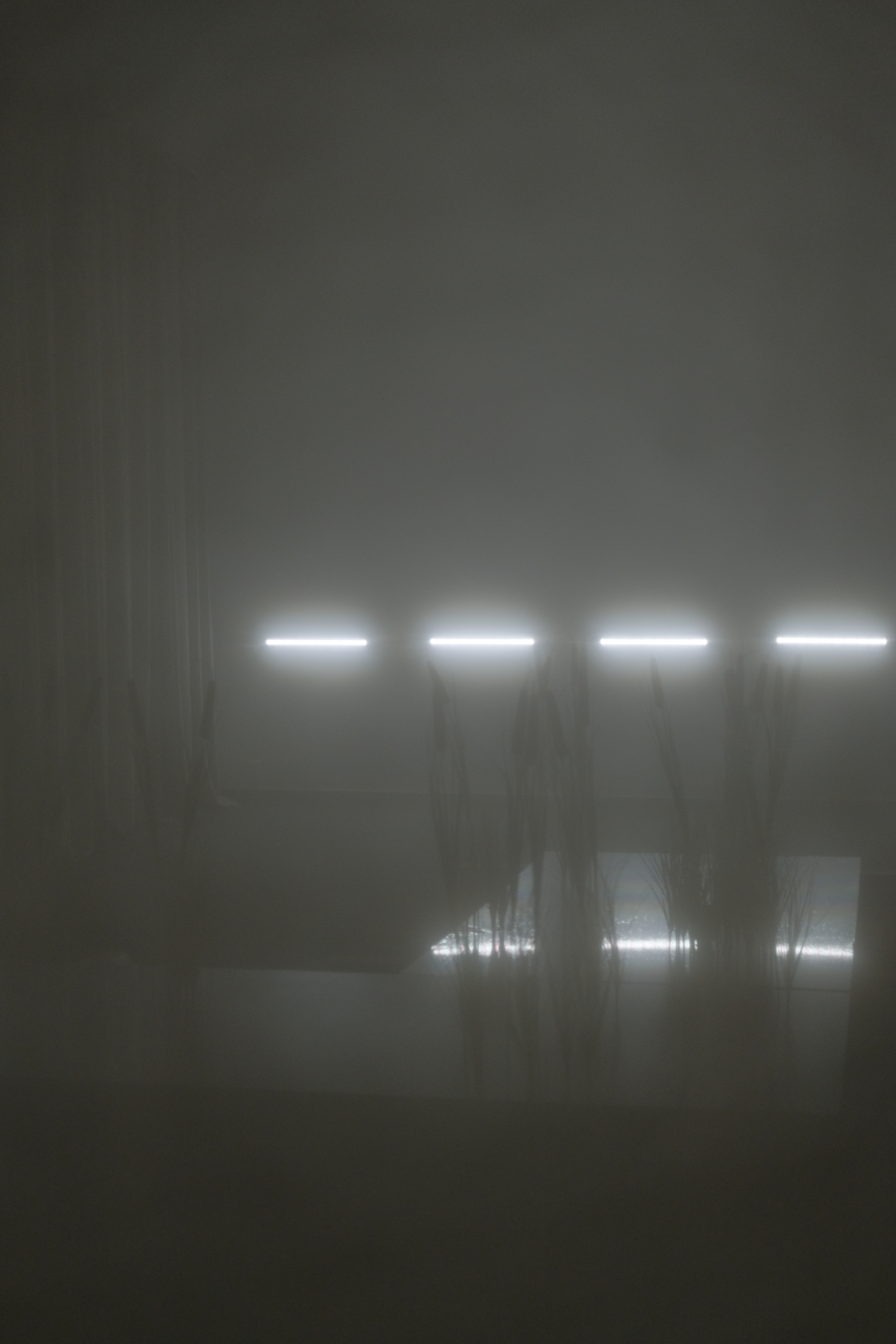
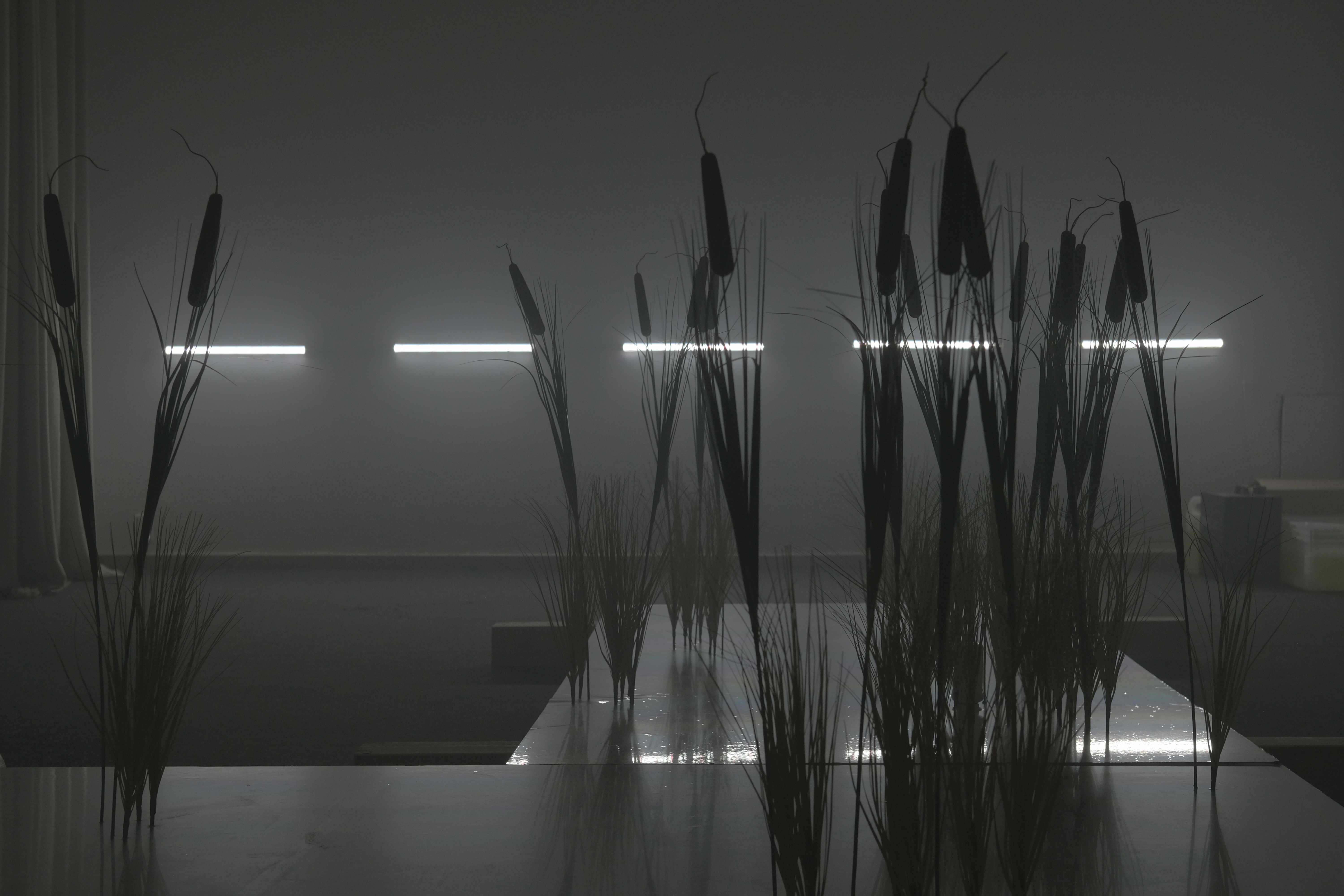

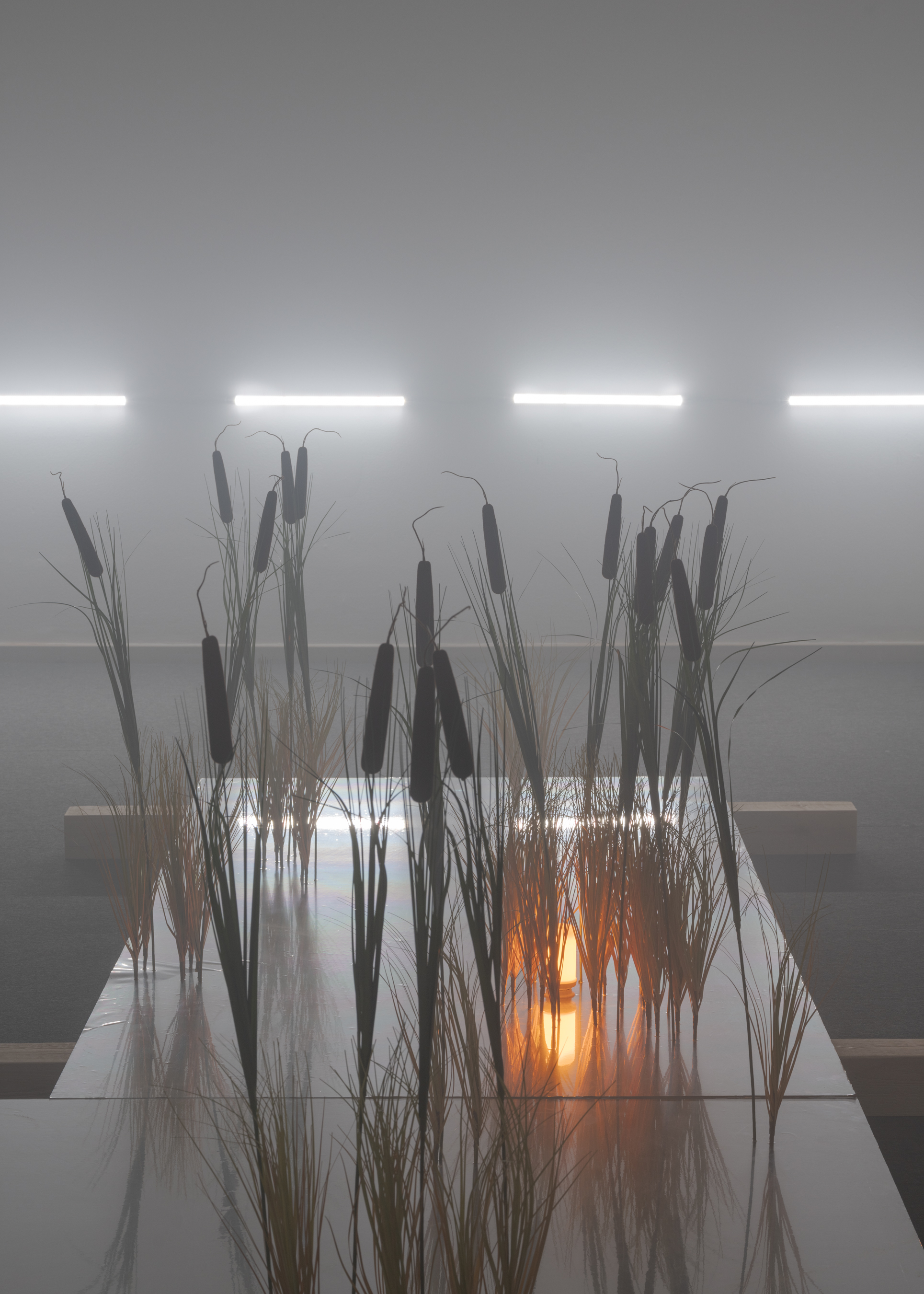

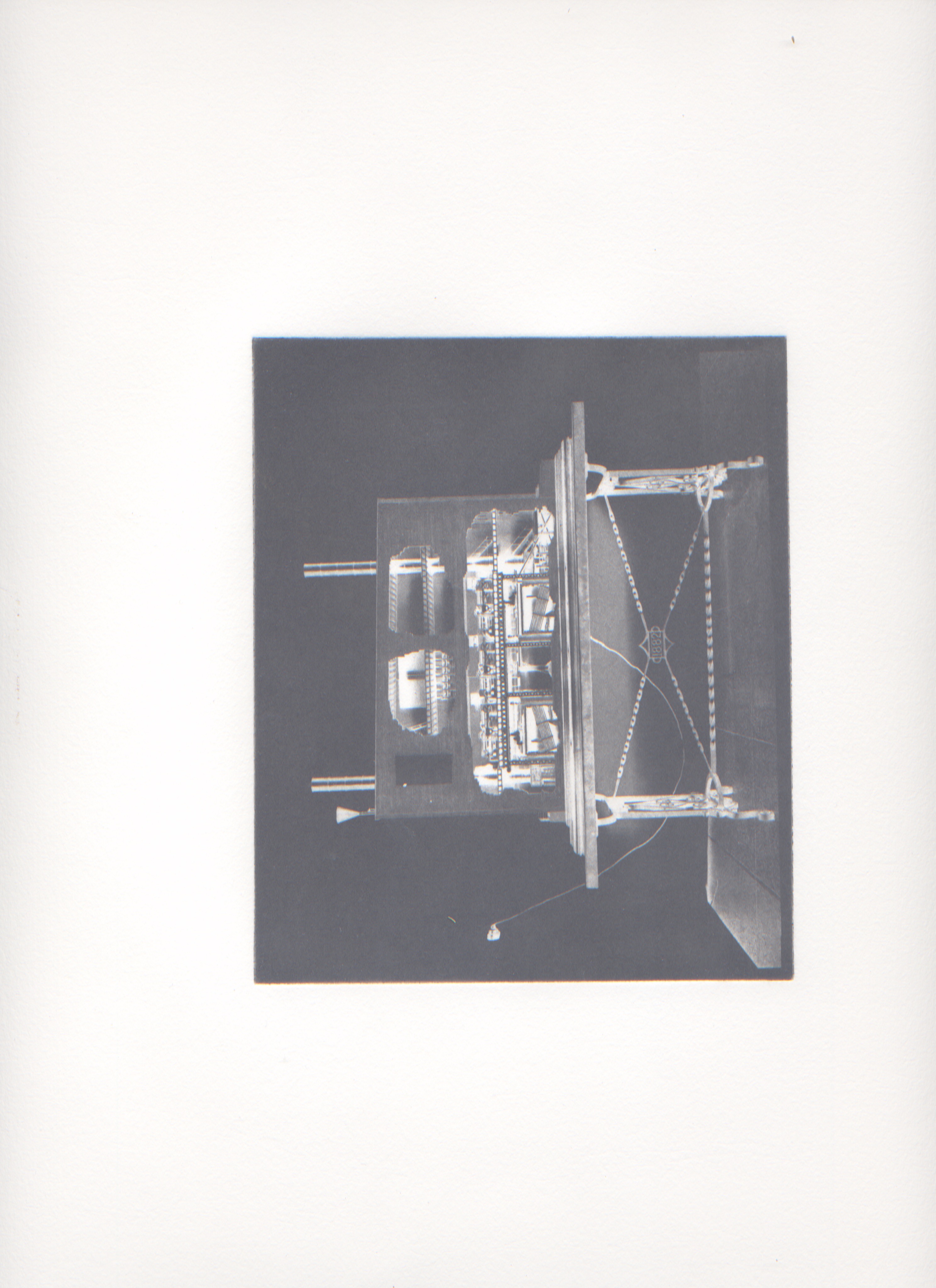

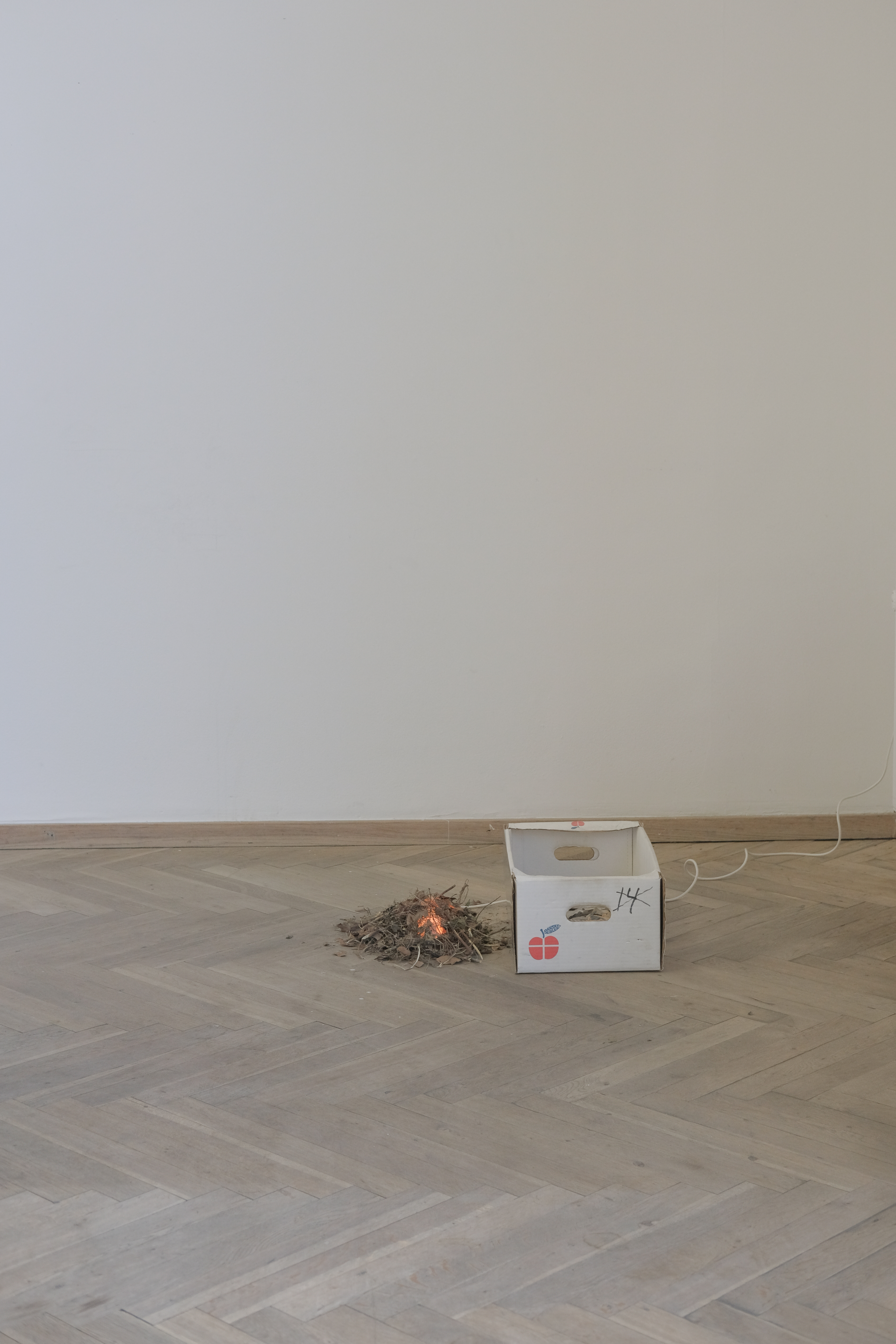
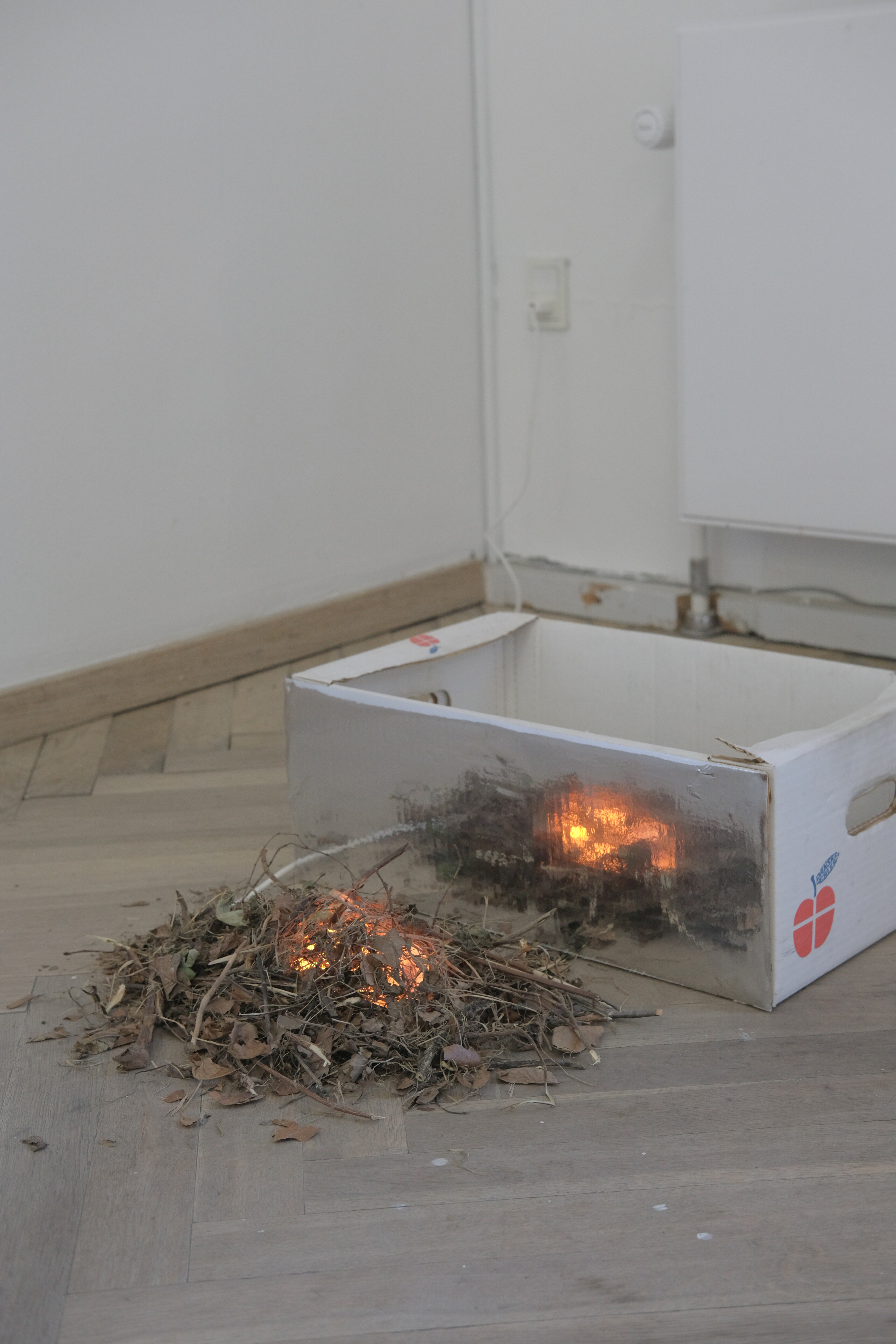
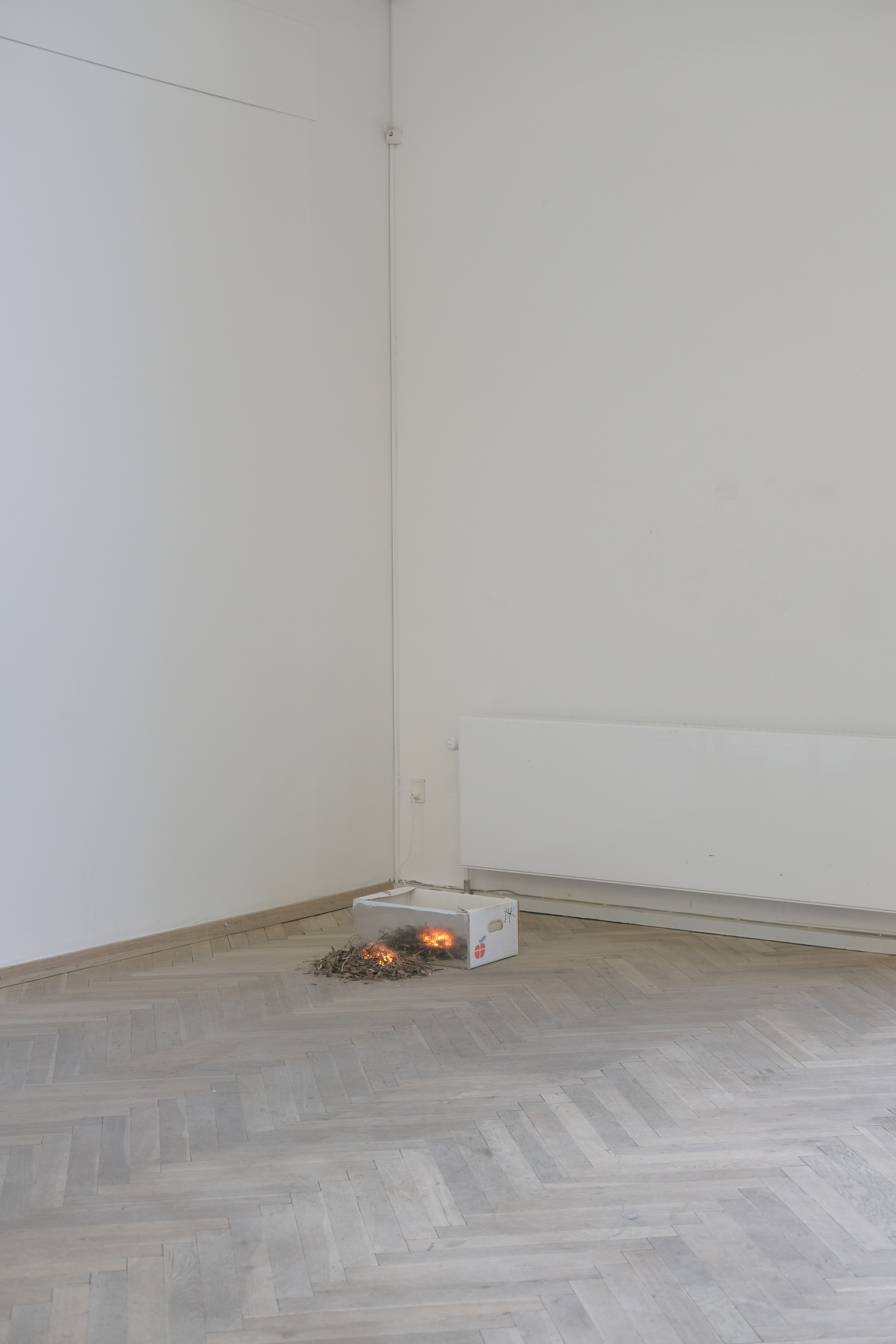
Impressionisms
AAAA Nordhavn
09.08.24 - 16.09.24
Gl. kalkbrænderi vej 68
Copenhagen, Denmark
The show Impressionisms reintroduces the tradition of French landscape painting from the late 18th century and into the present by employing literal methods of impressions and marks of pigment from fresh wildflowers gathered in the urban space of Copenhagen and acetone printing on birch plywood panels. French Impressionist landscape paintings namely of flower fields act as a prospect of the very place they were conceived and not only address the environmental awareness of the time but likewise, embrace the political and aesthetic gaze constituted in which the minimal impression and fleeting images were congratulated in contrast to the predecessor of fixed and representational painterly practices.
These ephemeral images represent not only a shifted turn in art history but also a time when photography and various new industrial innovations were part of changing the narrative arts representation and literal role into a merely abstracted and sensible experience embraced by all artistic fields across the Western art world, among other; composers, the arts and crafts movement and the literary circles. More than a decade later, as technological and industrial innovations continue to evolve rapidly within an interconnected global context, the prevalence of fleeting images persists and new techniques may arise from this constantly changing physical and digital environment.
An environment that both globally and locally is confronted with an urgent crisis of a decreasing biodiversity, destruction of landscapes in favour of big agriculture and an increasingly evolving city where local communities are threatened and where real estate industries defines the politics of land and the fields that they occupy. To encompass and emphasise this notion and the definition of fields and categorisation of land, various speculative grid-like figurations are transferred onto the panels with acetone, a formerly by-product material used as a solvent, to emphasise the territorial qualities and the similar speculative notion of maps, fields and land.
The gathering of flowers takes place from newly established flower meadows in Copenhagen initiated by the municipality in which new seed mixtures at 11 different locations are intended to create food and shelter for insects and birds as part of a new plan to enrich local biodiversity.The collected flowers are then stamped onto the panel for their pigment to absorb into the plywood and thus create and underline the geographical mark from where they were gathered and similarly an abstraction of that very field.
The series of 11 panels seeks to function as a revised flower field painting in which the flowers aren’t painted but rather, used for their pigment. The work intends to represent that very field, following the trajectories and traditions of Land art where the land or field as a place, concept and philosophical notion is represented in various ways as a means; to understand, contemplate and partake in our common fleeing environment.
Untitled (water body) 2024 plywood, vinyl foil, ball chain.
Champ De Fleur Sauvage No.1 (Vigerslevsparken) 2024
Acetone print and field flower impression on birch plywood.
Champ De Fleur Sauvage No.2 (Grøndalsparken) 2024
Acetone print and field flower impression on birch plywood.
Champ De Fleur Sauvage No.3 (Rødkildepark) 2024
Acetone print and field flower impression on birch plywood.
Champ De Fleur Sauvage No.4 (Bellahøj) 2024
Acetone print and field flower impression on birch plywood.
Champ De Fleur Sauvage No.5 (Tingbjerg) 2024
Acetone print and field flower impression on birch plywood.
Champ De Fleur Sauvage No.6 (Utterslev Mose) 2024
Acetone print and field flower impression on birch plywood.
Field (water body) 2024
Acetone print and vinyl foil on birch plywood.
Champ De Fleur Sauvage No.1 (Vigerslevsparken) 2024
Acetone print and field flower impression on birch plywood.
Champ De Fleur Sauvage No.2 (Grøndalsparken) 2024
Acetone print and field flower impression on birch plywood.
Champ De Fleur Sauvage No.3 (Rødkildepark) 2024
Acetone print and field flower impression on birch plywood.
Champ De Fleur Sauvage No.4 (Bellahøj) 2024
Acetone print and field flower impression on birch plywood.
Champ De Fleur Sauvage No.5 (Tingbjerg) 2024
Acetone print and field flower impression on birch plywood.
Champ De Fleur Sauvage No.6 (Utterslev Mose) 2024
Acetone print and field flower impression on birch plywood.
Field (water body) 2024
Acetone print and vinyl foil on birch plywood.
Champ De Fleur Sauvage No.7 (Rørsøstien) 2024
Acetone print and field flower impression on birch plywood.
Champ De Fleur Sauvage No.8 (Nørrebros Runddel) 2024
Acetone print and field flower impression on birch plywood.
Champ De Fleur Sauvage No.9 (Lergravsparken) 2024
Acetone print and field flower impression on birch plywood.
Champ De Fleur Sauvage No.10 (Assistens kirkegården) 2024 Acetone print and field flower impression on birch plywood.
Champ De Fleur Sauvage No.11 (Fredenspark) 2024
Acetone print and field flower impression on birch plywood.
Untitled (Ambience) 2024
FM radio, oxidized copper, ceramic vase, road median flowers.
Acetone print and field flower impression on birch plywood.
Champ De Fleur Sauvage No.8 (Nørrebros Runddel) 2024
Acetone print and field flower impression on birch plywood.
Champ De Fleur Sauvage No.9 (Lergravsparken) 2024
Acetone print and field flower impression on birch plywood.
Champ De Fleur Sauvage No.10 (Assistens kirkegården) 2024 Acetone print and field flower impression on birch plywood.
Champ De Fleur Sauvage No.11 (Fredenspark) 2024
Acetone print and field flower impression on birch plywood.
Untitled (Ambience) 2024
FM radio, oxidized copper, ceramic vase, road median flowers.
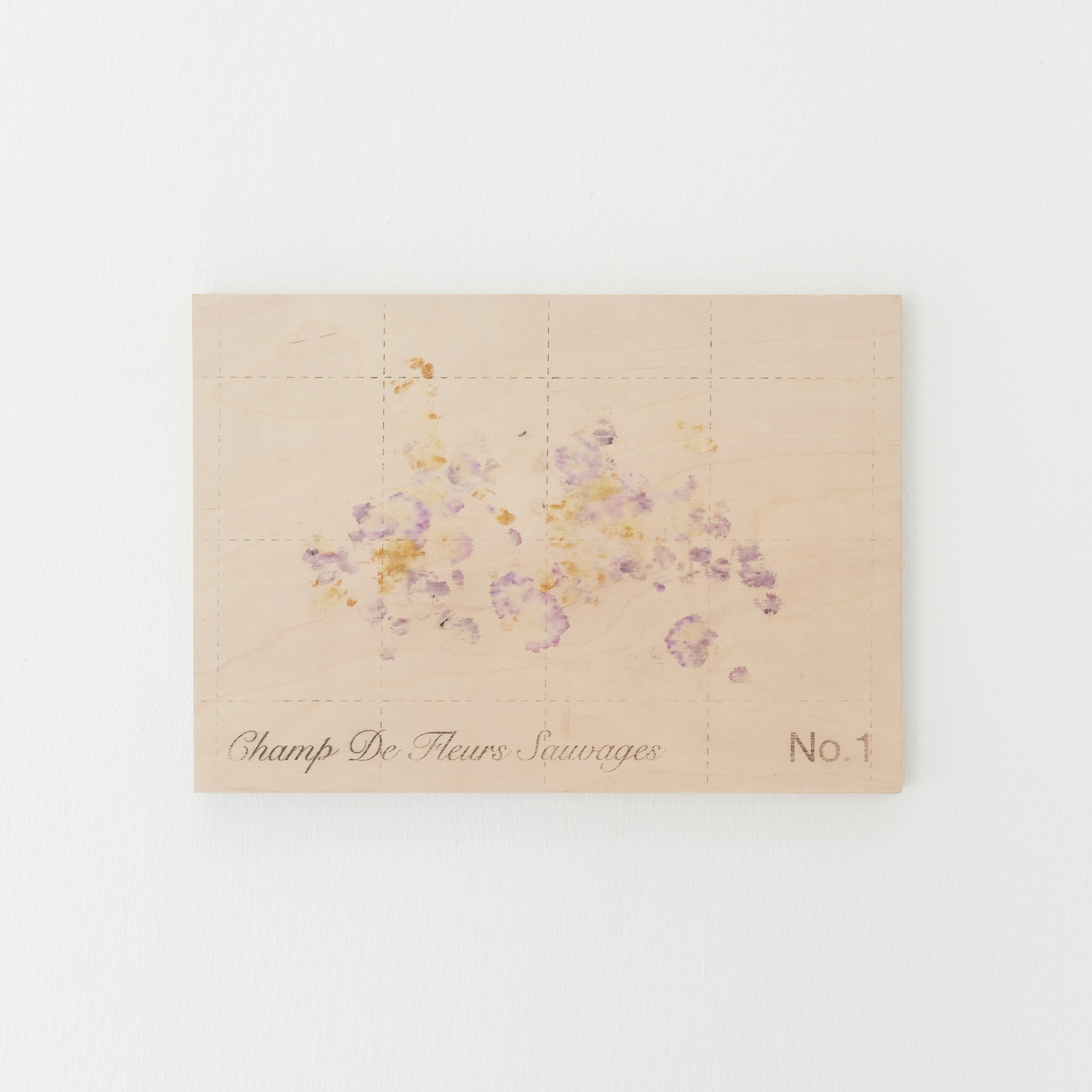





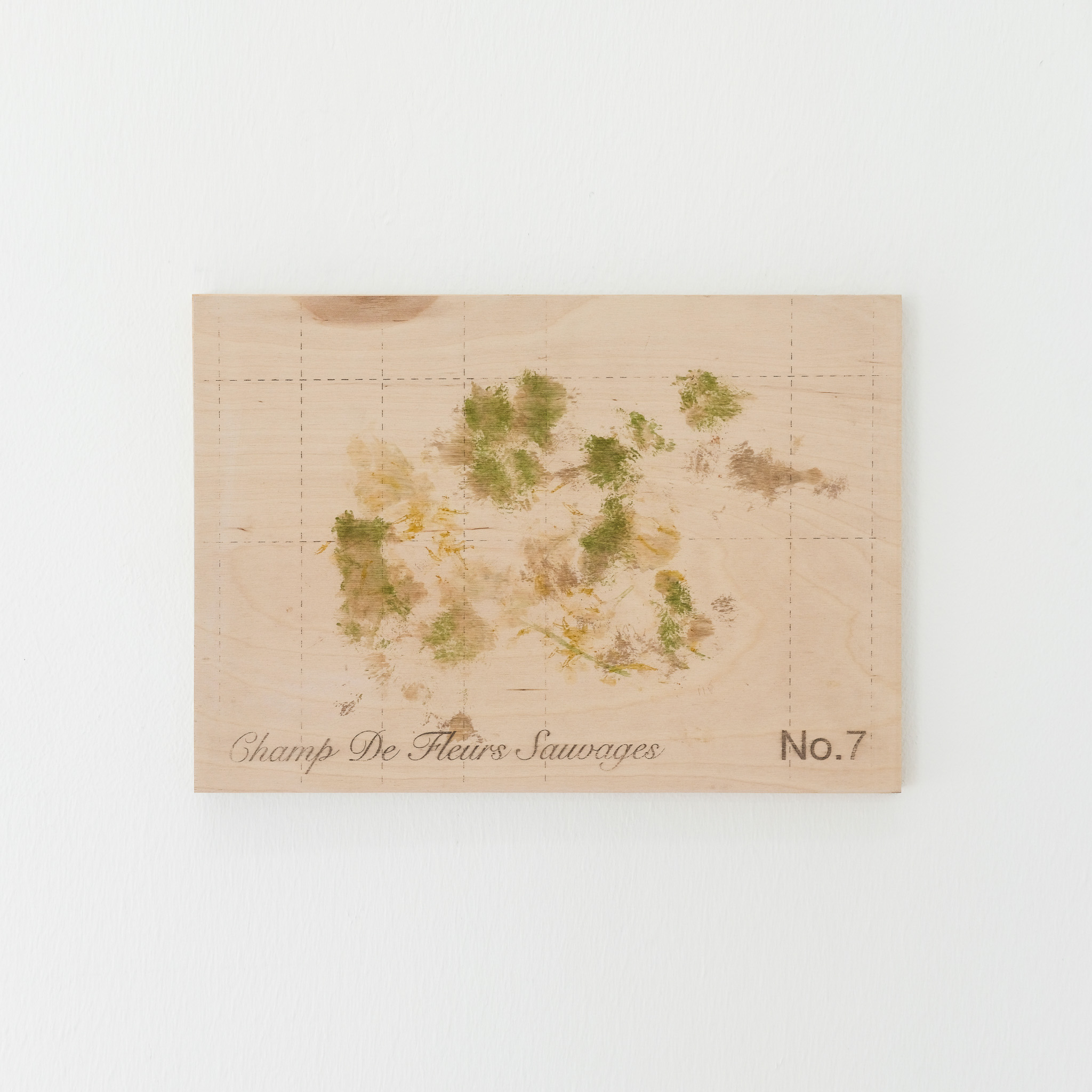










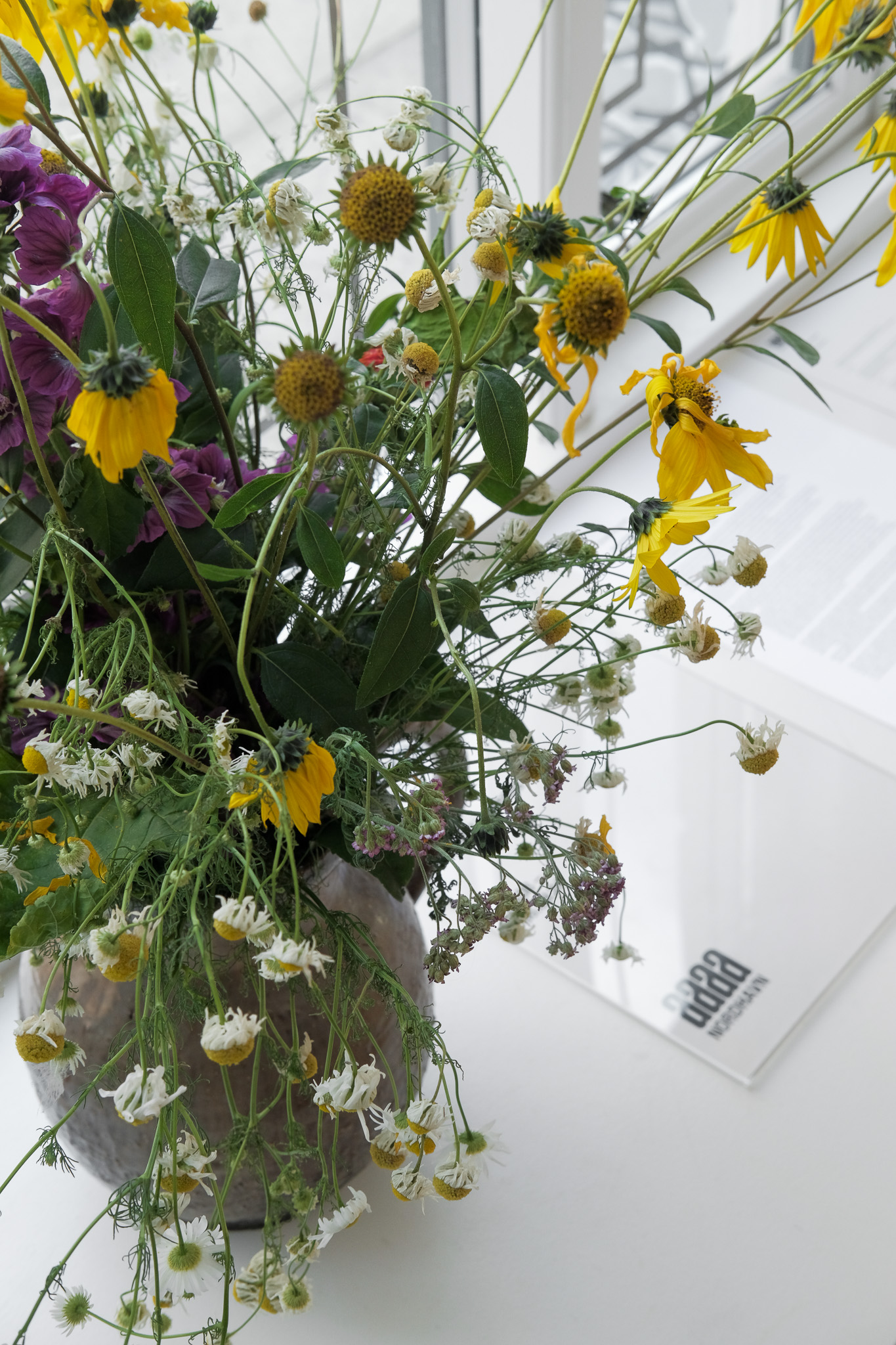

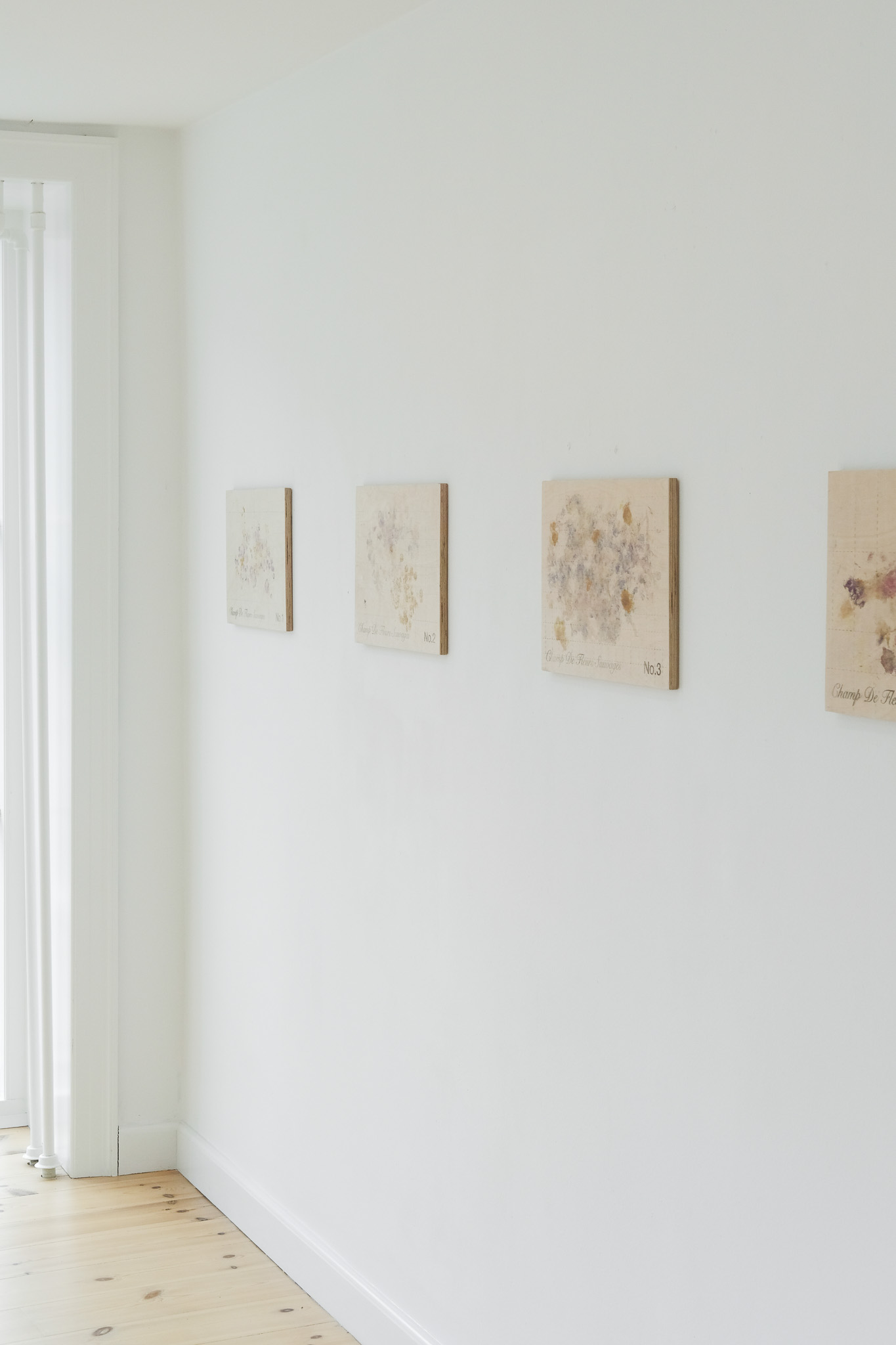


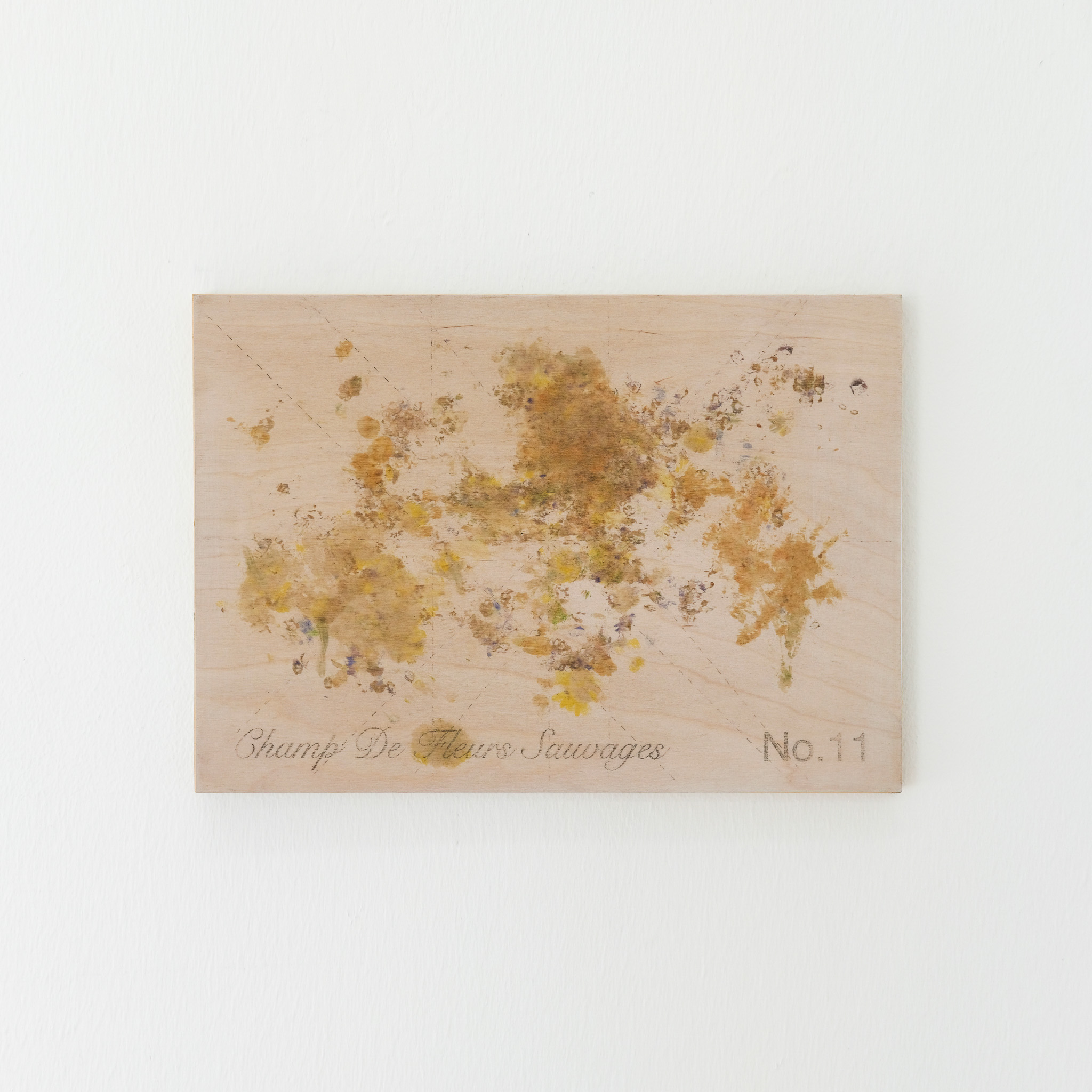

Land & History
Salon 75 @ Magma Maria
23 august - 8 september 2024
The exhibition Land & History by Salon 75 at Magma Marie presents new work by artists Hedvig Greiffenberg, Christine Dahlerup, Frej Volander Himmelstrup, Sofus Keiding-Agger, and Theodor Nymark. The presentation of works unfolds and examines the metaphorical quality of the politics and poetics of land and space, imposing a revised gaze onto the ephemeral and transformative aspect so pivotal to civilisation. The selection of works each represents the positioning of the practice of the artists concerning these very questions and in their common field of negating a threshold.

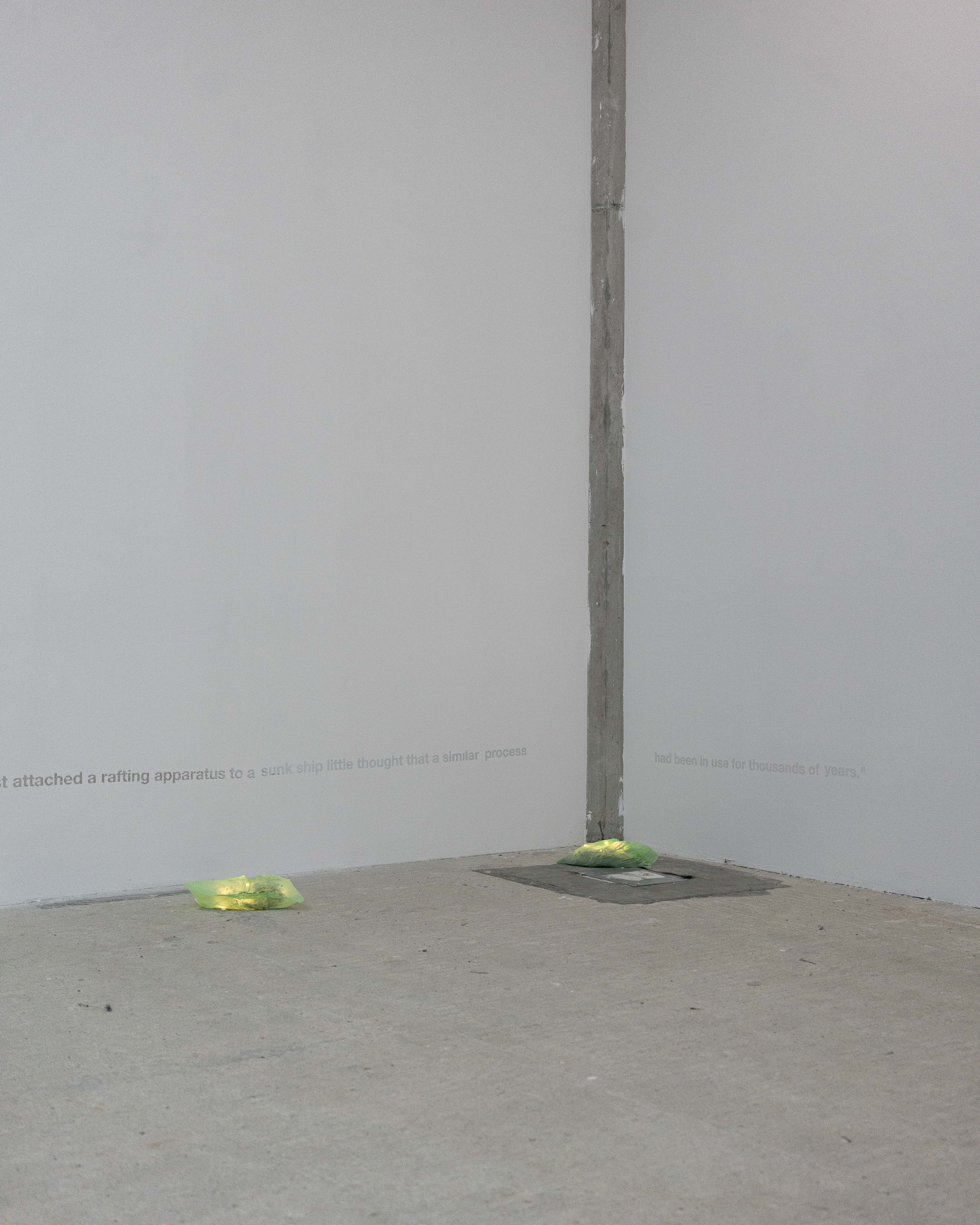
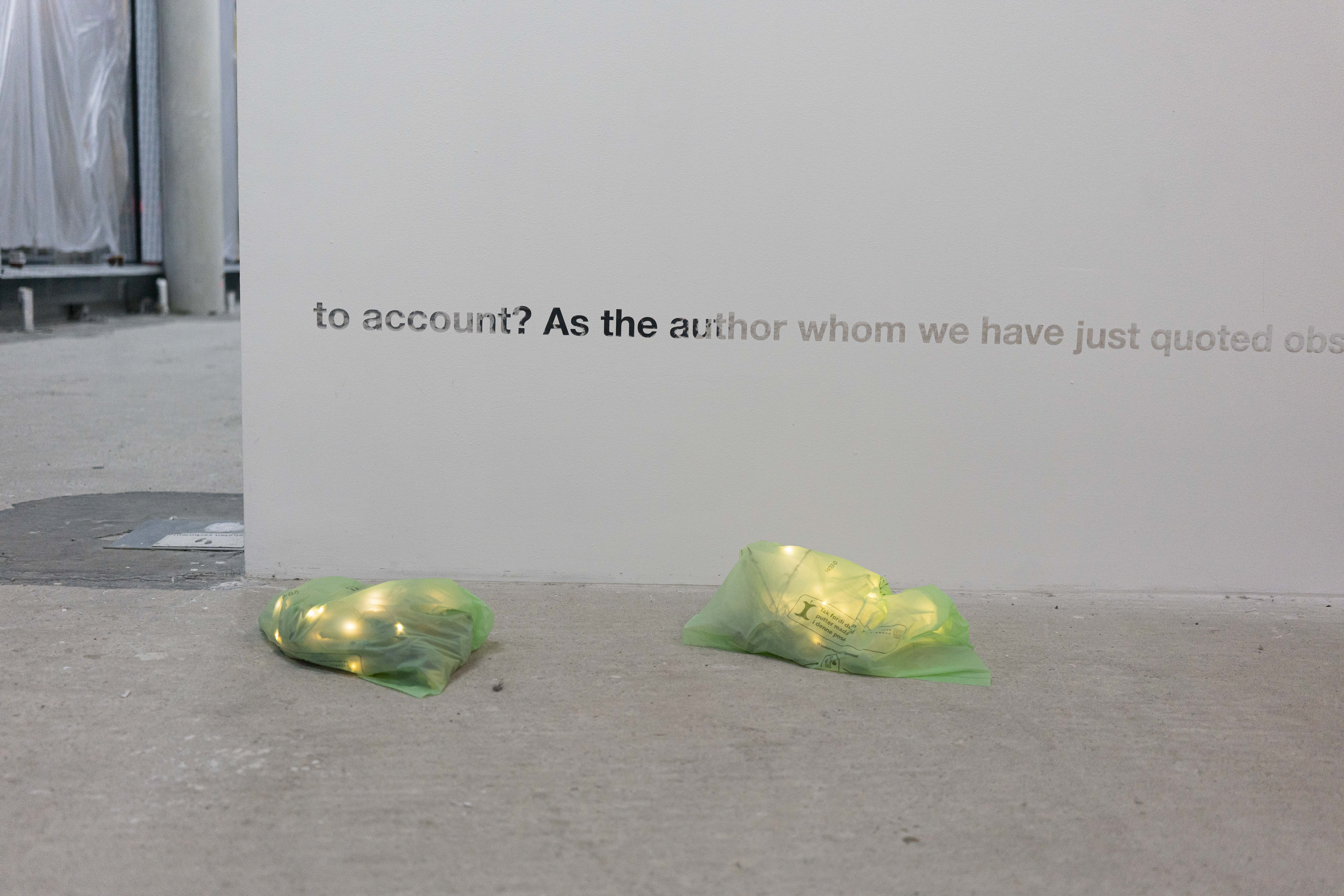
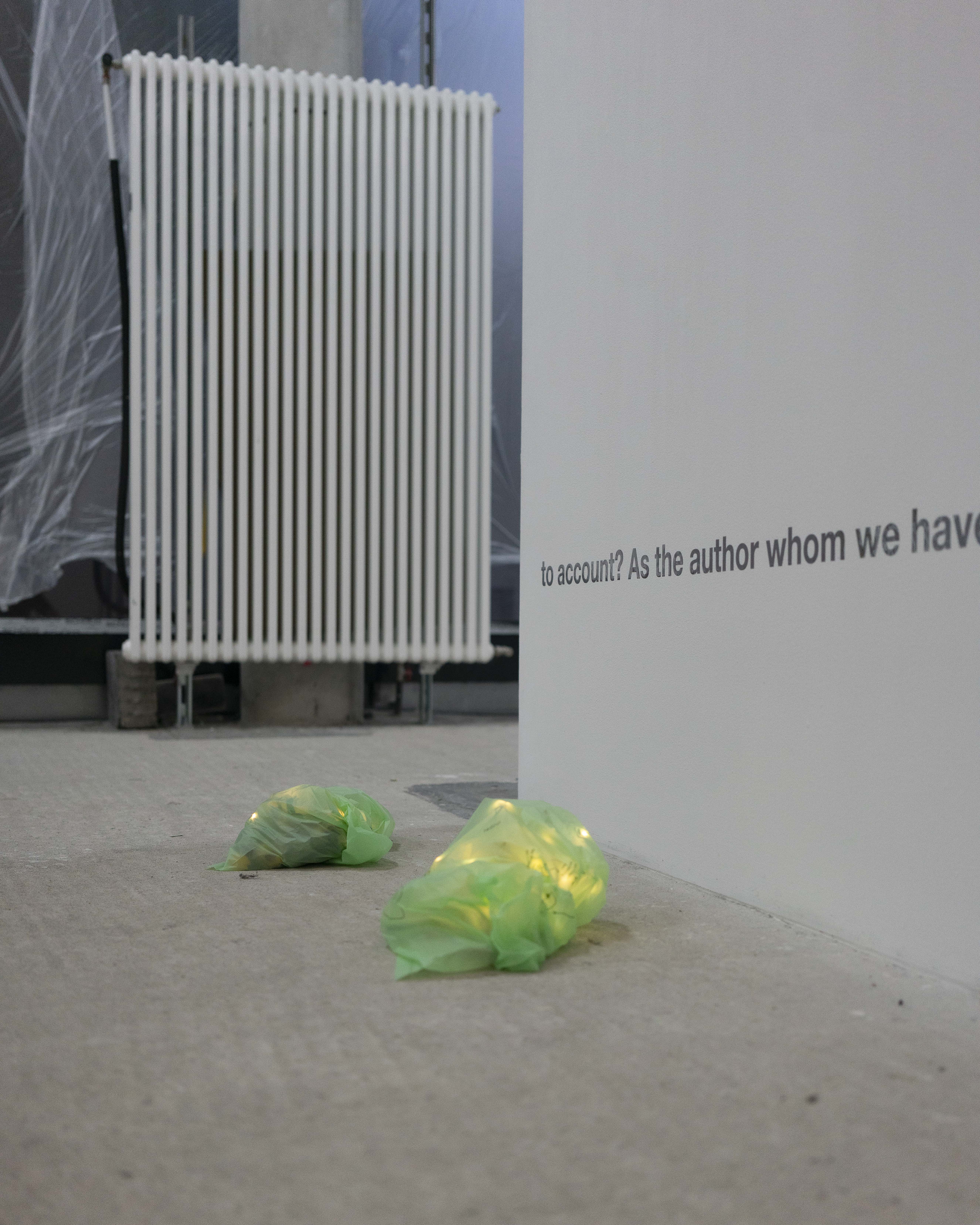


Untitled (resurrectionaries) 2024
Biodegrable bag, wildflowers, LED light and vinyl on wall.
The wall text is a draft from the book The Intelligence of Flowers by novelist and playwright Maurice Maeterlinck that became popular among pictorialist artists such as Baron Adolph De Meyer and Alvin Langdon Coburn for its abstract, playful depiction of the world of flowers and their metaphorical qualities and position in an industrial society which eventually inspired their work and the photographs of flower decorations.
Beneath it lies 4 branded bio bags from Copenhagen curled up on the floor along the wall that contains battery-powered LED lights and wildflowers gathered from the surrounding area of Magma Maria. These ephemeral and sculptural lamps wish to mimic a metaphorical depiction of energy transformed and generated within a biological compost system and similarly function and represent an encapsulation and mapping of the surrounding area.
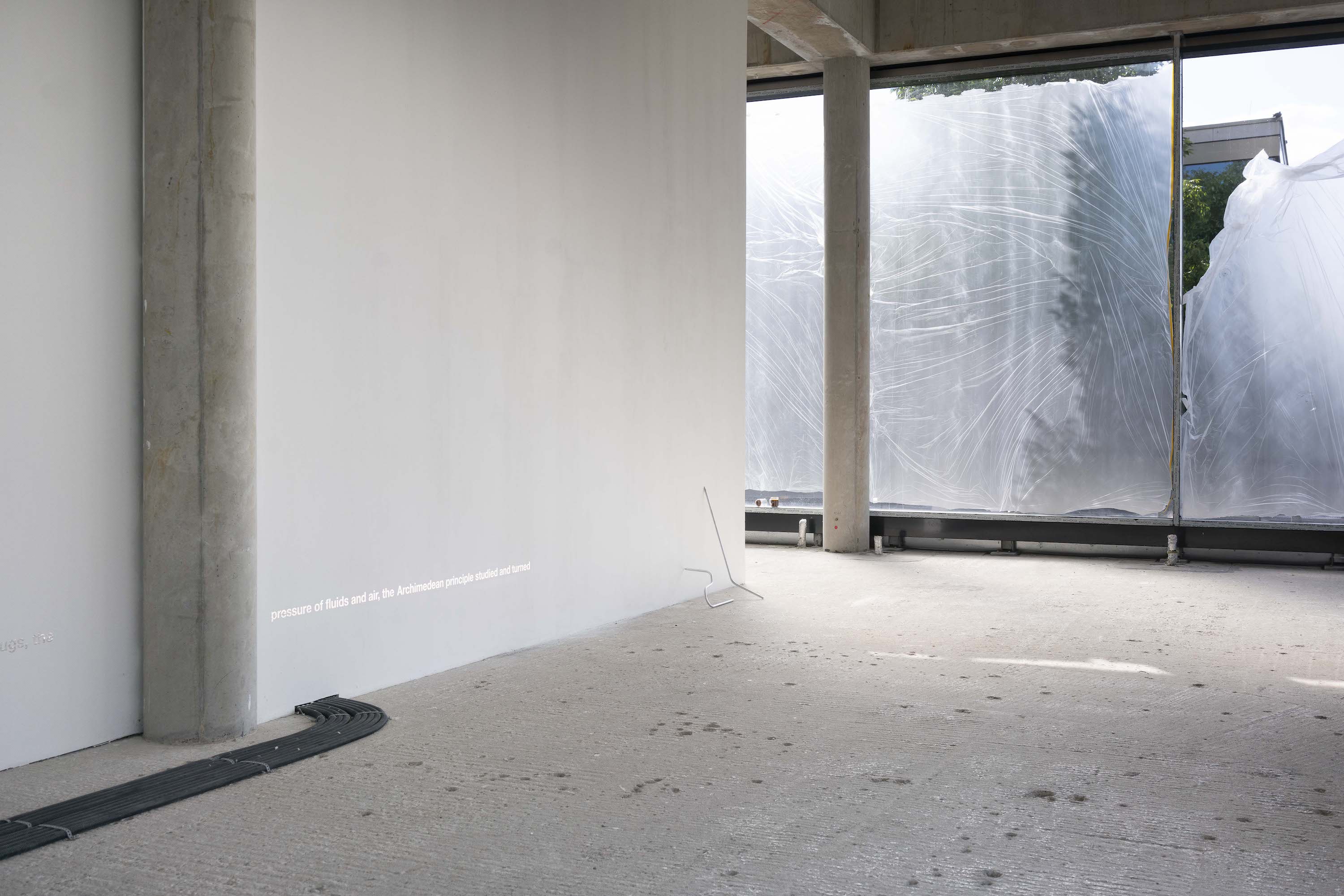


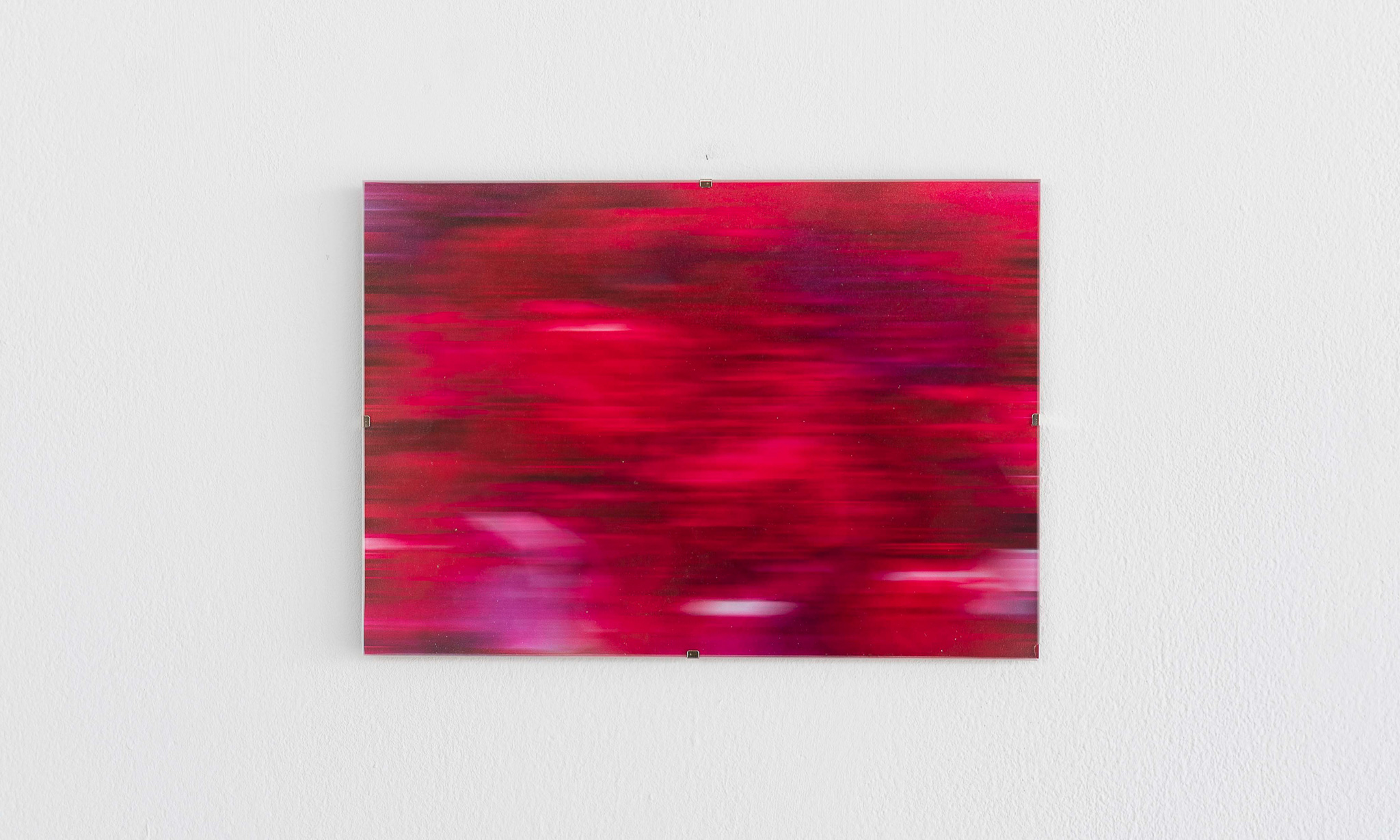
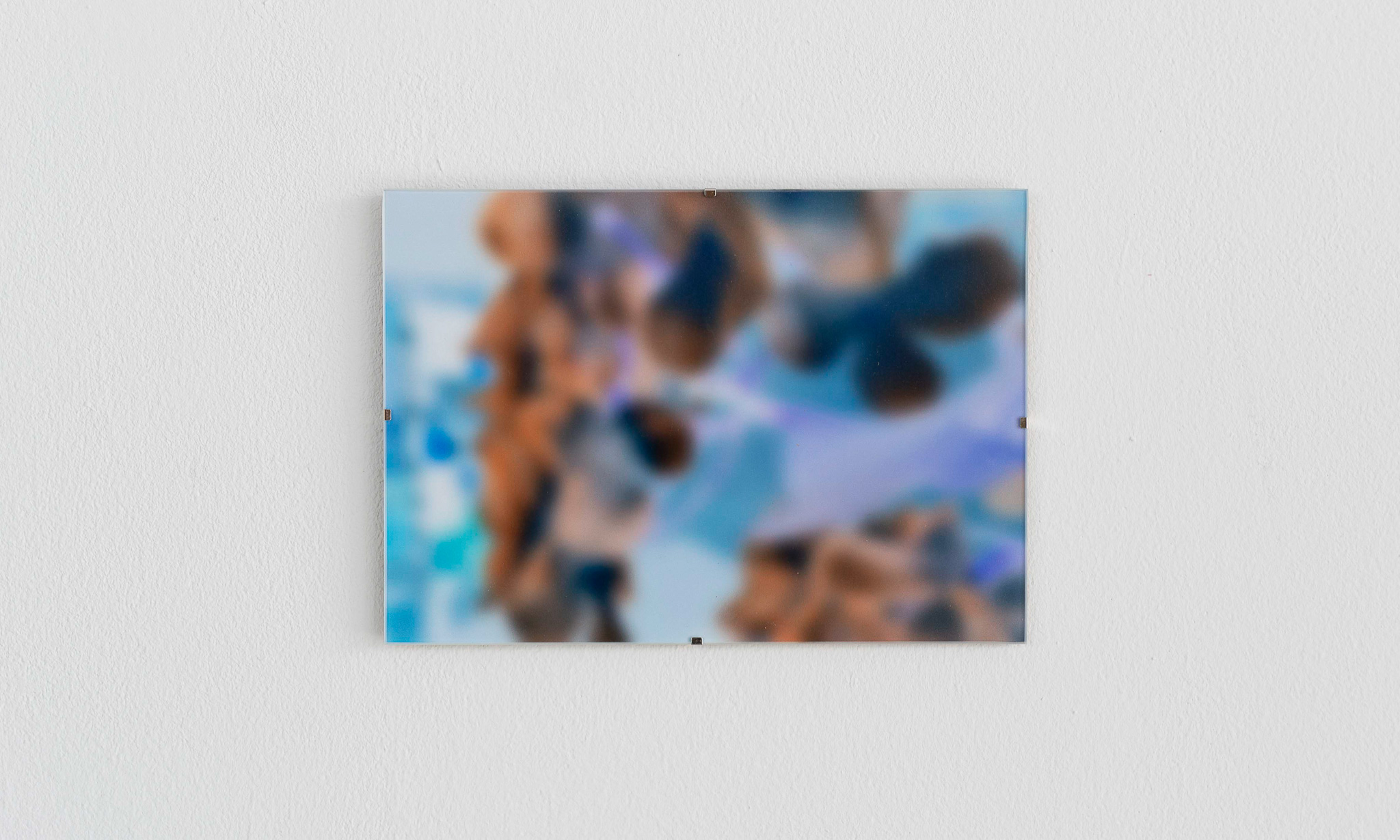
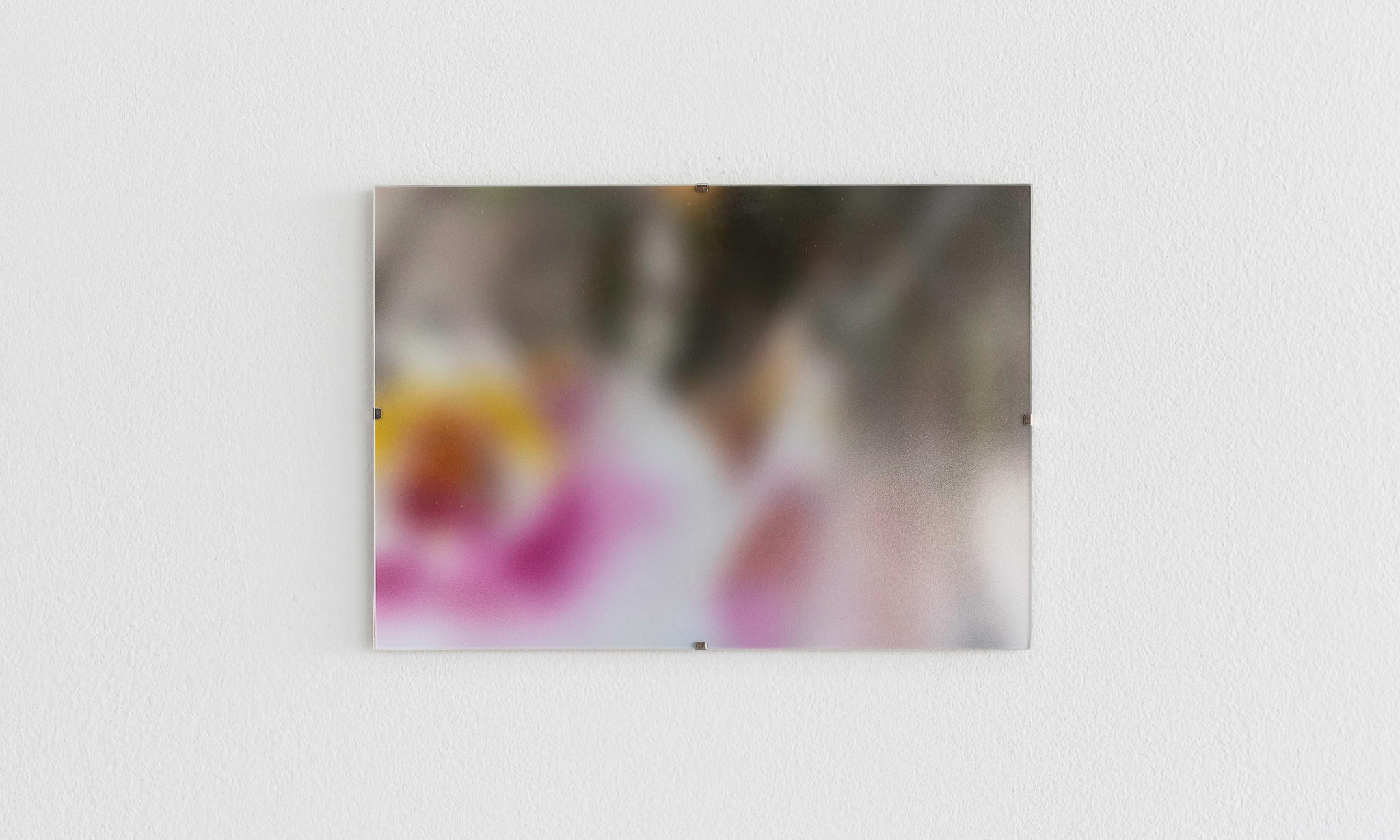
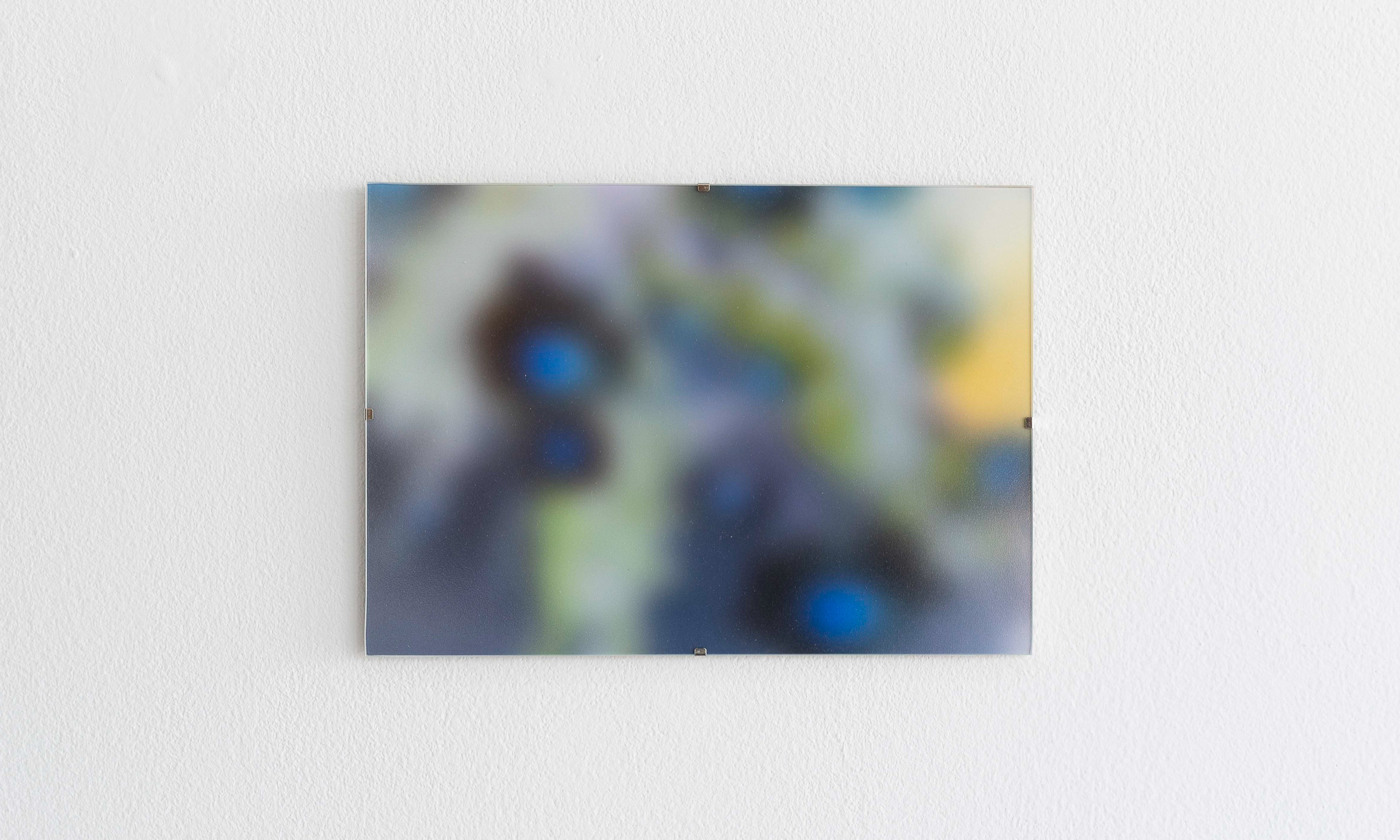

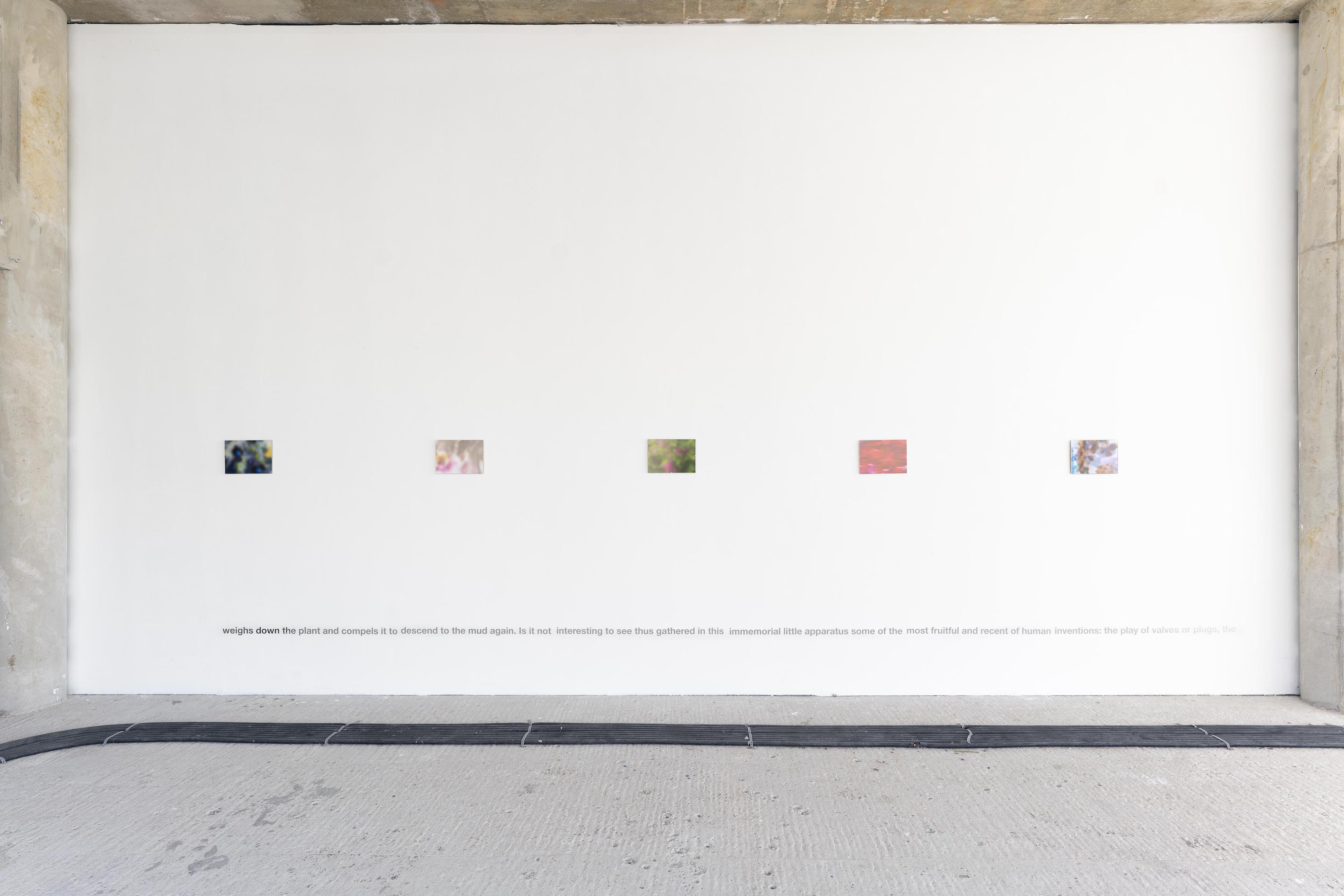
Untitled 1-5 (after Maeterlinck) 2024
Inkjet print on Hahnemühle in clip frame and vinyl on wall.
The photographic series represents a new body of work influenced by the Pictorialist movement of photography in the late 19th century, which explored not only the role of photography in art at the time but also delved into the ‘blurry’ or unsharp image and its reflection on themes of ecology, industry, and spirituality.
The framed pieces exhibited at Magma Maria are iPhone photographs with either inverted colors, Gaussian blur, or motion blur applied, and are printed in color on Hahnemühle paper. By employing contemporary methods and techniques rather than the traditional photographic strategies used during the Pictorialist movement, the project aims to reintroduce the notion of pictorialism and its intention to embrace the painterly, abstract, and possibly spiritual qualities of photography.
The title and wall text suggest a reference to the novelist and playwright Maurice Maeterlinck, specifically his publication "The Intelligence of Flowers," which became popular among Pictorialist artists such as Baron Adolph De Meyer and Alvin Langdon Coburn for its abstract and playful depiction of flowers and their metaphorical qualities and position in an industrial society. This work ultimately inspired their photographic explorations of flower decorations.
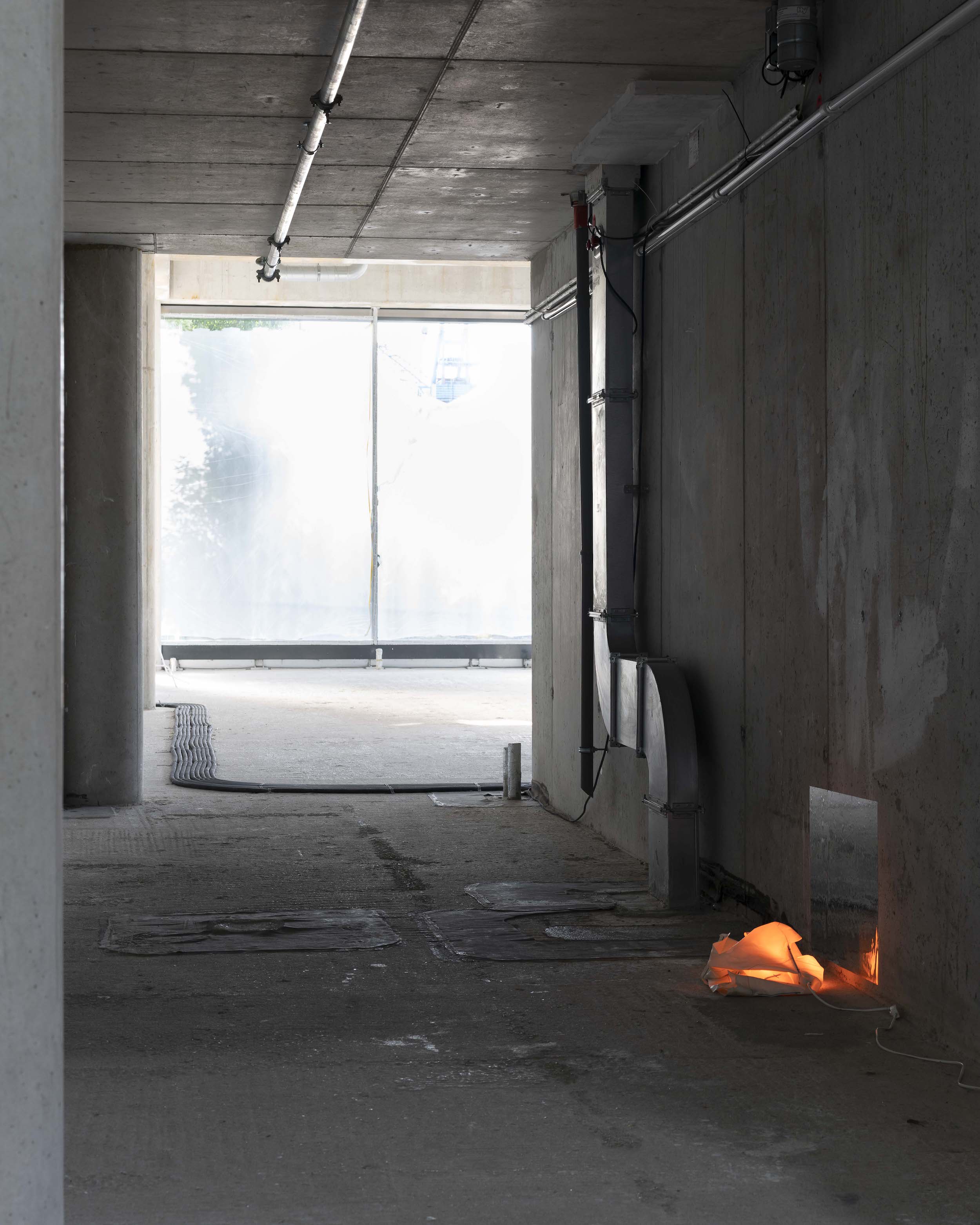
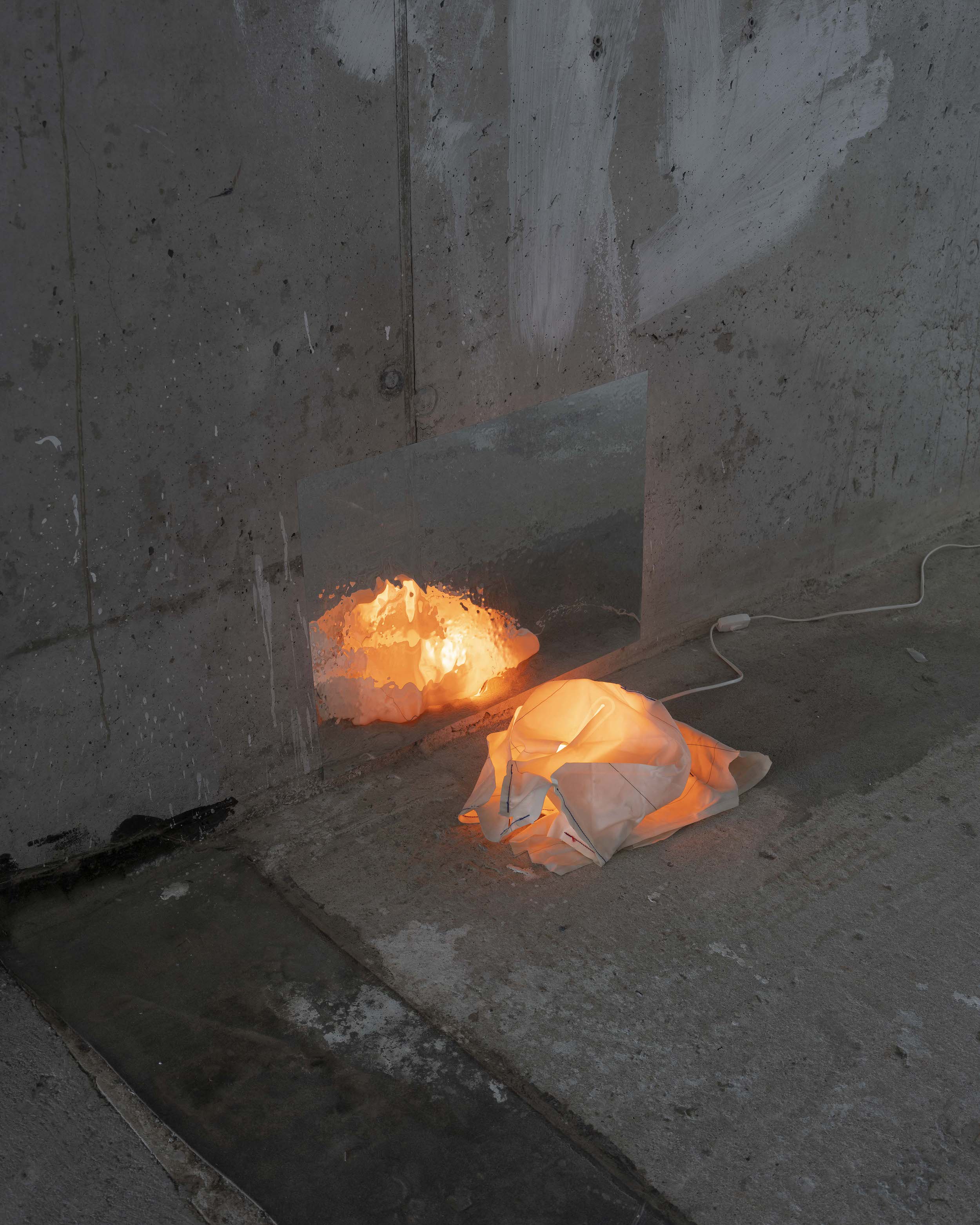
Hearth 2024
Bicycle helmet airbag (Hövding), LED flame bulb and vinyl on wall